Workbook

Engelsk for barnetrinnet
Bokmål

Tips
• Focus!
• Take school seriously!
• Be prepared!
• Ask questions!
• Work together!
• Explore new ideas!
• Try new things!



Bokmål

Tips
• Focus!
• Take school seriously!
• Be prepared!
• Ask questions!
• Work together!
• Explore new ideas!
• Try new things!

…is always happy.
name: _____________
…loves to write.
name: _____________
…speaks more than two languages.
name: _____________
…has short hair.
name: _____________
…can do a back flip.
name: _____________
…spoke a lot of English this summer.
name: _____________
…can whistle.
name: _____________
…has long hair.
name: _____________
…loves spicy food.
name: _____________
…has cleaned their room this week.
name: _____________
…plays an instrument.
name: _____________
…has curly hair.
name: _____________
…has secret superpowers.
name: _____________
…was born outside of Europe.
name: _____________
…has broken a bone sometime.
name: _____________
…can make cupcakes.
name: _____________
…is an only child.
name: _____________
…has the same colour eyes as you.
name: _____________
…likes broccoli.
name: _____________
…walked barefoot this summer.
name: _____________
…has a brother and a sister.
name: _____________
…has their birthday in March.
name: _____________
…likes to sing in the shower.
name: _____________
…slept outside this summer.
name: _____________
…has the most letters in their name.
name: _____________
NB! Try to ask as many different people as possible. Do you…? Did you…? Are you…? Were you…?
NB = Nota Bene (Italian) = Please note (English). It means something is important.
Yes, I do. No, I don’t.
Yes, I did. No, I didn’t.
Yes, I am. No, I’m not.
Yes, I was.
No, I wasn’t.
Listen to Luke and Leia talk about who they are.
a) What does Luke say about himself? ________________________________________________________________________________ ________________________________________________________________________________
b) What does Leia say about herself? ________________________________________________________________________________ ________________________________________________________________________________
c) You probably have an opinion about who you are. Other people also have an opinion about you. Fill out this form about yourself. Write as much as you can.
Who am I?
Your own opinion
Your teacher’s opinion
Your friend’s opinion
Your parent’s opinion
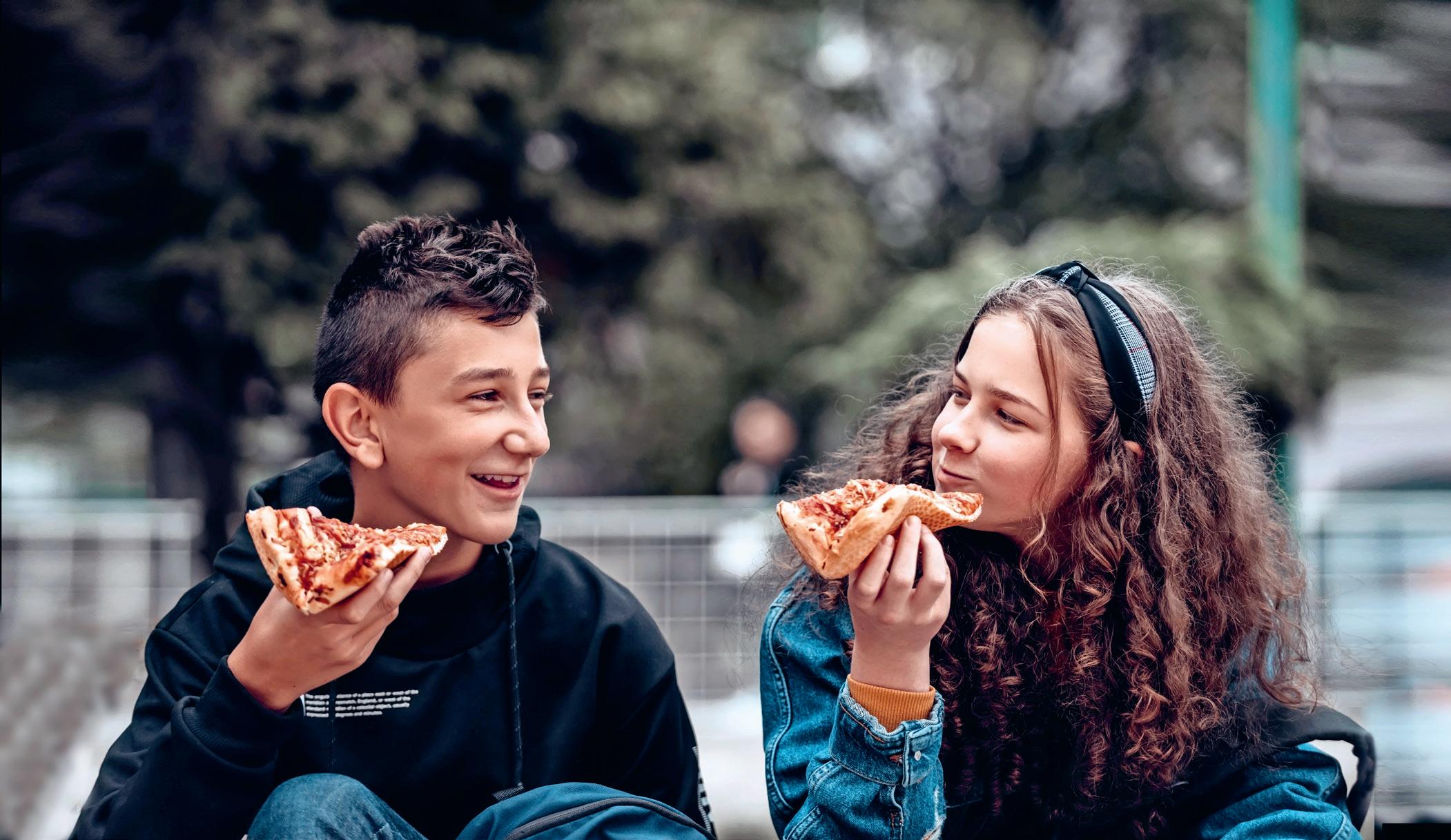
“I am poems” are a way to express ideas about yourself. I Am Every Good Thing is an example of an “I am” poem. Here’s part of the poem:
“I am a non-stop ball of energy. Powerful and full of light.
I am a go-getter. A difference-maker. A leader.”
(Barnes, 2020)
There are different types of “I am” poems and they follow different patterns. Here is an “I am” poem Thea wrote.
I am Thea, a free spirit
I hear the sounds of baby lambs
I see the beauty this world has
I touch the hearts of animals
I smell the coming of spring
I feel excited when I learn something new
I worry about melting glaciers
I am sad about the people who are suffering
I am happy when I can care for others
I believe life is full of opportunities
I dream of a day when there is peace in the world
I hope for a snowy winter
I am Thea, a free spirit
1.3 Write your own “I am” poem. You can write it like this, following Thea’s example.
I am…
Something you hear
Something you see
Something you touch
Something you smell
Something you feel
Something you worry about
Something that makes you sad
Something that makes you happy
Something that you believe in
Something you dream about
Something you hope for Repeat the first line of the poem
Check your peer’s text
What kind of text has your peer written?
Which text-type features do you know of?
Name two text-type features your peer used.
Write something that worked well in the text.
Write the sentence you like the most.
Find three new or interesting words.
What did you get out of reading this text?
- Learned something?
- Was entertained?
- Enjoyed it?
- Was persuaded?
- Was moved?
- Got to know the author?
- Something else?
Other?
1.4 Interview your learning partner.
I am interviewing: ____________________________________________
A biographical text is a text written about someone else’s life.
This is one way to write a biographical text.
Family: ________________________________________________________________________________
Which words best describe you? ________________________________________________________________________________
Who is your role model? ________________________________________________________________________________
What are you good at? ________________________________________________________________________________
Why do you like these activities? ________________________________________________________________________________
What do you want to be when you grow up? ________________________________________________________________________________
What are your hopes for the future? ________________________________________________________________________________
(Your own question) ________________________________________________________________________________
(Your own question) ________________________________________________________________________________
1.5 Write a biographical text about your learning partner on a digital device or by hand.
A paragraph is a series of sentences that are organised and have to do with the same topic or theme. A paragraph is indicated by a new line or indentation.
Example 1
A topic sentence is a sentence that introduces the main idea in a paragraph. All the other sentences in the paragraph are connected to the topic sentence. Topic sentences help the readers to know what the paragraph will be about and understand the rest of the paragraph.
Role models are people you look up to (living or dead, real or fictional) that inspire you. Role models can be famous people who you admire because of something they did, made, or achieved. They can also be someone close to you, such as a good friend or a family member. Role models can inspire us to reach for, and achieve, our personal goals in life.
Here the topic sentence tells us that we will be reading about role models. Are all the other sentences in this paragraph about role models?
Example 2
There are many different types of sea animals. In the ocean there are large animals like whales and sharks, but there are also small fish. I also like tigers, lions, and bears. I would like to visit the jungle. My favourite sea animal is the walrus.
Here the topic sentence tells us that the paragraph will be about different types of sea animals. Are all the other sentences in the paragraph about types of sea animals? Which sentences would you need to change so they all fit?

a) Write a topic sentence that fits the sentences in the paragraphs below.
1 Topic sentence: ________________________________________________________________________________ ________________________________________________________________________________
Skiing, snowboarding, and skating are some examples. I like making snowmen and snow angels. My older sister likes snowball fights. No matter what you do, get out in the winter!
2 Topic sentence: ________________________________________________________________________________ ________________________________________________________________________________
Dogs need walks every day. They also need mental activity and challenges. It is not enough to just give them food and water. A dog is more than just a pet, it is a member of the family.
b) Write your own paragraph including a topic sentence and at least 3 other sentences that relate to your topic sentence.
Here are some ideas of topics you can write about, but you can choose your own! your favourite book your favourite sport or activity your favourite animal your family
________________________________________________________________________________ ________________________________________________________________________________ ________________________________________________________________________________ ________________________________________________________________________________ ________________________________________________________________________________ ________________________________________________________________________________
c) ✔ Self assessment. Check your own work above.
Do I have a topic sentence?
Does it cover the main idea of all of the sentences in the paragraph?
Do you remember what verbs, nouns, and adjectives are? See Textbook pages 190–191.
Scan the text and mark the verbs with green, the nouns with red, and the adjectives with blue. Write the words that you mark in the table on the bottom of the page.
22nd of August
Dearest Mimi, Today is the saddest day of my life!! Ibrahim is moving away, and today was the last day at school. We’ve been best friends since kindergarten and we’ve been “Ellie and Ibra” forever!
I don’t even know who I am without him! Ellie is nothing without her Ibra! This SUCKS!
Eleanor 1st of September
My dearest Mimi, I haven’t thought about anything else than Ibrahim for the last few days, but tonight something happened! Earlier this week, Diana from 7B invited me to her party. I’ve always thought of her as a bit scary, but as it turns out, she’s actually really nice! And tonight, at her party, she kissed me! On the lips! And… I liked it. Wow! WHAT?!
2nd of September
Mimi, So, Diana sent me a message. It said: I’m thinking about you! And a heart emoji. Am I going to answer? I like her too, but… I have to say something. I can’t just ghost her. I don’t want to ghost her! I kind of like her. I think.
Eleanor 3rd of September
I did answer her….
You won’t believe this! Ibrahim told me today that he’s got a girlfriend from his new class. And you know what?! I got really jealous. Why did that happen? Was I ever in love with him? Am I in love with him right now? Am I in love with Diana? This is just sooo confusing. I really need your help, Mimi!
Verbs NounsChallenge: Find words in the text from other word classes. See Textbook pages 191–194.
Pronouns: ________________________________________________________________________________
Adverbs: ________________________________________________________________________________
Determiners: ________________________________________________________________________________
Prepositions: ________________________________________________________________________________
What is your name? ________________________
How old are you? ________________________
What is your favourite memory from this summer? ________________________________________________________________________________ ________________________________________________________________________________ ________________________________________________________________________________
What are you looking forward to this year? ________________________________________________________________________________ ________________________________________________________________________________ ________________________________________________________________________________
Do you have any goals? Academic? Sports? Personal? ________________________________________________________________________________ ________________________________________________________________________________ ________________________________________________________________________________
What do you like most about your friends? ________________________________________________________________________________ ________________________________________________________________________________ ________________________________________________________________________________
How would your friends describe you? ________________________________________________________________________________ ________________________________________________________________________________ ________________________________________________________________________________
What do you want to be when you grow up? Why? ________________________________________________________________________________ ________________________________________________________________________________ ________________________________________________________________________________
What do you think you’re good at? ________________________________________________________________________________ ________________________________________________________________________________ ________________________________________________________________________________
Who would you say is your most important role model? Why? ________________________________________________________________________________ ________________________________________________________________________________ ________________________________________________________________________________
If you could, would you travel to the future or to the past? Why? ________________________________________________________________________________ ________________________________________________________________________________ ________________________________________________________________________________
If you could have a superpower, what would you choose? Why? ________________________________________________________________________________ ________________________________________________________________________________
Prepare a sentence to close the interview: ________________________________________________________________________________ ________________________________________________________________________________
Read the letters by Aryan, Jonathan, and Mercy (in Textbook, pages 24–25) and identify the relationships between them and the recipients. Place a cross (X) on each of the lines.
a) Aryan
How close do you think Aryan is to the recipient?
How powerful is the recipient in relation to Aryan?
How old do you think the recipient is in relation to Aryan?
In the letter, did you find any words or phrases that helped you decide where to place the crosses? What were they?
Is there anything Aryan should have changed in the letter? Why / Why not?
How does Aryan address the recipient in the letter?
________________________________________________________________________________ ________________________________________________________________________________
How does Aryan finish the letter? ________________________________________________________________________________ ________________________________________________________________________________
How close do you think Jonathan is to the recipient?
How powerful is the recipient in relation to Jonathan?
How old do you think the recipient is in relation to Jonathan?
In the letter, did you find any words or phrases that helped you decide where to place the crosses? What were they? ________________________________________________________________________________ ________________________________________________________________________________
Is there anything Jonathan should have changed in the letter? Why / Why not?
How does Jonathan address the recipient in the letter?
________________________________________________________________________________ ________________________________________________________________________________
How does Jonathan finish the letter? ________________________________________________________________________________ ________________________________________________________________________________
How close do you think Mercy is to the recipient?
How powerful is the recipient in relation to Mercy?
How old do you think the recipient is in relation to Mercy?
In the letter, did you find any words or phrases that helped you decide where to place the crosses? What were they? ________________________________________________________________________________ ________________________________________________________________________________
Is there anything Mercy should have changed in the letter? Why/ Why not?
How does Mercy address the recipient in the letter? ________________________________________________________________________________ ________________________________________________________________________________
How does Mercy finish the letter? ________________________________________________________________________________ ________________________________________________________________________________
d) In the three texts, do you notice any differences in how Aryan, Jonathan, and Mercy address their recipients? What are the differences? ________________________________________________________________________________ ________________________________________________________________________________ ________________________________________________________________________________ ________________________________________________________________________________
e) In the three texts, do you notice any differences in how Aryan, Jonathan, and Mercy finish their letters? What are the differences? ________________________________________________________________________________ ________________________________________________________________________________ ________________________________________________________________________________ ________________________________________________________________________________
f) In the three texts, do you notice any differences in the words and phrases that Aryan, Jonathan, and Mercy use? If so, what are the differences? ________________________________________________________________________________ ________________________________________________________________________________ ________________________________________________________________________________ ________________________________________________________________________________

Pretend that you are one of the role models in the letters in Textbook page 25 and respond to Aryan, Jonathan, or Mercy. How do you think they will answer the letter? Do you think they will use some kind of specialised language, that is, words that would be common for their backgrounds or their professions? For instance, perhaps a politician would use words that are common in politics, such as “election” and “campaign”, in their response.
Opening: This is where you greet the recipient.
Main text: This is where you add information, such as why you’re writing, and answer questions.
Closing: This is where you sign off with your name.
a) Pick your own role model and think about why they are your role model. Write keywords.
b) Write a message to your role model where you ask them for information on something that you’re curious about, for instance, some choices they made, how they live, and so on.

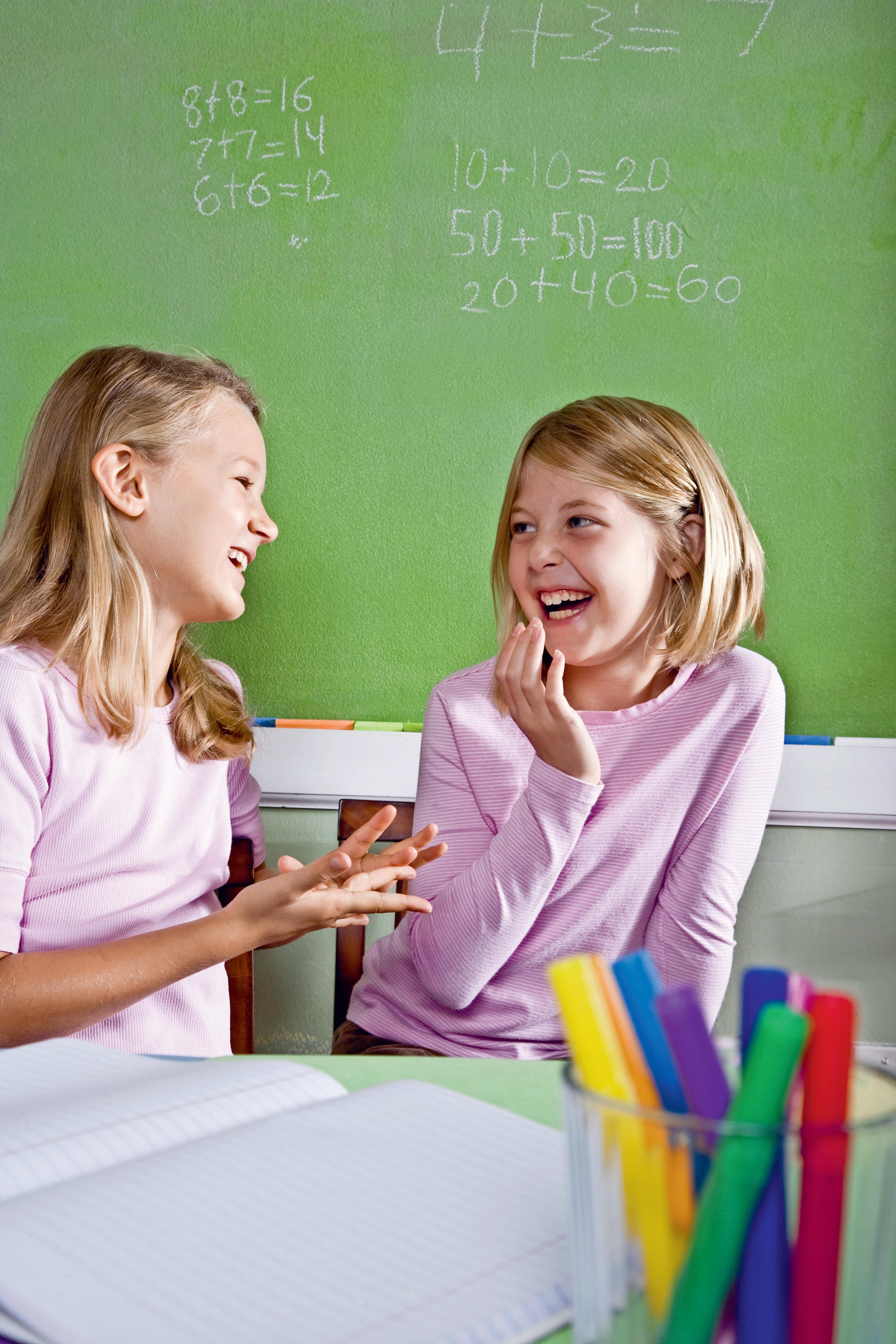
I can participate in a conversation.
Talk to your learning partner. What do you like to do in your spare time? How did you get interested in that? Did someone encourage you to get started?
Talk to your learning partner. How would you describe your taste in clothes or music? What has influenced your choices?

I can identify text type features in a text I have read.
Choose one of the texts you have read in chapter 1, for example Dear Mimi.
Title of the text: ____________________________________________________________
Text type: ___________________________________________________________
Which text type features do you find in the text? ___________________________________ ___________________________________
I can give and receive feedback on texts.
Choose a text you have written in this chapter. Get feedback (two stars and a wish) from a learning partner. Use a checklist for support.
__________________________________________________________________
__________________________________________________________________
__________________________________________________________________
I can reflect on and talk about my own identity.
Talk to your learning partner. Do you act differently around different people? In what ways? Who are you when you are with your friends? Who are you when you are alone? Who are you at school, or when you are with your grandparents?
Communication forms
Verbal communication
Your examples
See Textbook page 32 for support.
Non-verbal communication
Written communication
Active listening
Visual communication
a) Choose two symbols. In your opinion, what do the symbols mean? ________________________________________________________________________________ ________________________________________________________________________________
b) How do you think the symbols communicate that meaning? ________________________________________________________________________________ ________________________________________________________________________________
c) Which symbols do you recognise from your daily life? ________________________________________________________________________________ ________________________________________________________________________________
d) What kind of communication do you use during the day? In a week? ________________________________________________________________________________ ________________________________________________________________________________
Challenge: Think about what the word communication means. Try to explain it to someone in your own words.
There are many words that can be offensive. Often it depends on who you are talking to. There are also words that sound mean for some but not for others. Some words sound worse in one language than another, or they mean different things in different languages. Examples are nice, cool, shit, idk.
a) Brainstorm alone
List words or phrases, from any language, that you have heard people use to express their feelings. They might be from the schoolyard, in video games, with friends, etc.
b) With your learning partner
– Compare your lists.
– Are you surprised by anything? What?
– Are some of the words or phrases in English? If so, why is that, do you think?
– Do you often use English words or phrases in your everyday speech? Why, or why not?
c) In what ways can roasting be hurtful? ________________________________________________________________________________ ________________________________________________________________________________ ________________________________________________________________________________
Roasting can mean to criticise someone in an angry way. Roasting in some contexts means to tell unkind jokes about someone, but in a friendly way as a form of tribute.
See Textbook page 34.
1 Where is Kim from?
A: Bergen B: London C: Oslo
2 How old is Kim?
A: 10 years old B: 12 years old C: 15 years old
3 What is Kim writing to Dr Dina about?
A: Monsters under the bed B: Bullying C: Bad language
4 What do Kim’s friends call him when he reacts to this?
B: Old fashioned C: Idiot D: Uptight
5 When do Kim’s friends use bad language?
D: On the weekends E: All the time F: Often
6 Does Kim ever use swear words himself?
F: Never G: Often H: Sometimes
7 “Don’t these words lose their _______ when they are used all the time?”
I: effect J: power K: intensity
8 “It sounds as if your friends use swear words instead of _______.”
S: intensifiers T: nice words U: normal words
9 According to Dr Dina, what would Kim’s friends show about themselves if they use words such as “extremely boring” or “totally awesome” instead of swear words?
S: That they are responsible T: That they have a large vocabulary
U: That they are smart
10 According to Dr Dina, when is it okay to shout a swear word?
S: Never T: When you are together with friends
U: When you, for example, hit your little toe on the table leg
Why is swearing like an old coat?
2.5 Hiding behind the keyboard?
Technology has advantages and disadvantages. One advantage is that it allows people to communicate and discuss topics with other people all over the world. It also allows people to use fake names to hide their identity. In Textbook pages 35–36, Nicholas and Alexandra were both using fake names when playing online.
a) Do you think Nicholas was thinking about the person on the other end (Alexandra) when he wrote the message? Why / Why not? ________________________________________________________________________________ ________________________________________________________________________________ ________________________________________________________________________________
b) How do you think it made Alexandra feel? ________________________________________________________________________________ ________________________________________________________________________________ ________________________________________________________________________________
c) What could Nicholas have done differently? ________________________________________________________________________________ ________________________________________________________________________________ ________________________________________________________________________________
d) Why do you think some people behave differently when they are anonymous online? Write down what you think and share it with your learning partner. ________________________________________________________________________________ ________________________________________________________________________________ ________________________________________________________________________________
The fact that people can hide their identity online also means that we have to be careful when we read and communicate.
Consider the following messages. Which one do you think is more trustworthy? Draw a circle
ClimateChangeIsAHoax @ClimateHoax
The report from the IPCC (United Nations) is in. Climate change is real and we need to wake up. Change must happen NOW! Read more here:
https://www.ipcc.ch/ 9:00 PM · Apr 23, 2022
Reminder: Climate change is not real. Climate change is not manmade. Climate change is not dangerous. The truth is in this video:
https://www.youtube.com/ 9:00
Why do you think this one is more trustworthy? ________________________________________________________________________________ ________________________________________________________________________________

2.7 Create a list of things to be aware of online. ________________________________________________________________________________ ________________________________________________________________________________ ________________________________________________________________________________ ________________________________________________________________________________
2.8 Compare your list with your learning partner’s list. Do you have similar items on your list? Write down the things you have in common.
Linking ideas in a paragraph
It helps the reader to understand how the ideas are connected when we link ideas in a paragraph. We can also use linking words to give us clues about the order of the different parts of the text. We have learned about some linking words before, such as in comparison, on the other hand, in addition, and finally. There are also other types of linking words: pronouns, conjunctions, linking adverbials, time adverbials. We can also use synonyms, antonyms, and repetition of words we have already used.
Example 1
James has a dog named Charlie. He likes to chew on bones. (Here we need to understand that “he” refers to Charlie and not to “James”.)
Example 2
Mercy has a dog named Scout. He likes to chew on bones. (Here there is no confusion. “He” can only refer to Scout.)
Example 3
In this example, linking words are underlined and arrows are drawn from the linking words to the ideas they refer back to.
Fruit and vegetables we eat have been pollinated by bees. Pollination is a very important part of the life cycle of plants and they cannot produce fruit or vegetables
without it. That’s a bee’s job. Right now, the bees are at risk because of climate change. They are losing their homes. This has made it difficult for bees to do their very important job.
a) Underline the words that refer back to earlier ideas. Draw arrows between the words that you underlined and the words they refer to.
Rebecca and Elisabeth enjoy reading. Their favourite books are fantasy novels. They enjoy reading about different places, magic, and talking animals.
Sometimes they read the same book and other times they trade. Their goal is to read 30 books this summer. Last summer they each read 25. Elisabeth thinks it will be easy, but Rebecca is not sure. Elisabeth reminds her that she can change her goal along the way if she wants to.
b) Fill in the missing words that can better connect ideas in this paragraph.
they they
their then
there at first finally they
James and his dog Charlie decided to try skiing. _________________ found some ski tracks in the woods. _________________ they met some other people and their huskies.
_________________, the huskies wanted to play together. After a while, _________________ started to race each other down the ski tracks. _________________, all the huskies and _________________ owners made it back to the ski stadium. _________________ all agreed to meet _________________ together next week.
c) Challenge: Choose a text you have written. Find and highlight or circle the linking words you have used to connect ideas across sentences. Ask a partner for help.
This is Helen Keller. What do you think she is doing?

2.10 Listen to the text and circle the correct answer.
a) When was Helen Keller born?
A 1813 B 1850 C 1880 D 1905
b) Where was Helen Keller born?
L Connecticut, USA M London, UK N Trondheim, Norway O Alabama, USA
c) How old was Helen when she became blind and deaf?
L She was born like that M A year and a half N 10 years old O 15 years old
d) How did she communicate with her parents at first?
M She used hand signs N She wrote O She sang P She didn’t communicate
e) What was the name of Helen’s teacher?
S Anne Keller T Miss Andrews U Anne Sullivan V Mike Moo
f) What is a manual alphabet?
M A normal alphabet N An alphabet using fingers O An alphabet with Æ, Ø, Å
g) What’s the name of a written language for the blind, using raised dots?
F Feel-alphabet G Dots H Campus I Braille
h) What did Helen learn at 9 years old?
C To read lips D To ride a bike E To speak French F To cook
i) When did Helen Keller die?
Z 1850 A 1968 B 1990 C 2019
j) Where did Helen Keller die?
T Connecticut, USA U London, UK V Trondheim, Norway W Alabama, USA
k) How many signs did Helen use to communicate with her parents when she was 7?
C 2 D Almost 40 E Almost 60 F 1500
Which word did you get? ________________________________________________________________________________
This time, write down keywords. Use these keywords to talk about different ways of communicating. In what ways do you communicate other than speaking?
A personal text can be written or visual, where people tell about things like their own experiences, opinions, memories, fears, or other things. We often use written and/or visual communication.
2.12
a) Write keywords for each statement.
– I have no use for English in my life.
– I use so much English that I forget my own language.
– We learn too little English at school. ________________________________________________________________________________ ________________________________________________________________________________
b) To get started writing your personal text, choose one of the statements in part a. Make two columns and label them “for” and “against”. Think of reasons why someone might argue for that thing or against it.
When you are done with your list, write (or record) a personal text. Choose to write in the style of a journal, diary, blog, or vlog.
c) Share your text with someone in your class.
I can express myself clearly in a spontaneous conversation.
Talk to your learning partner about your favourite food. Follow these steps:
1 First sit back to back, so you don’t see each other’s faces.
2 Then talk face to face but sit on your hands (no body language).
3 Then talk face to face using body language.
Talk to your learning partner. Which of these steps did you prefer as the person talking? Which did you prefer as the person listening? When and how often do you use body language? Why do you use it? Remember to take turns and listen to each other.
I can ask questions about a text I have read.
Choose one of the texts you have read in this chapter. Write down some questions about the text, and ask your learning partner.
I can write a cohesive text appropriate to the reader.
Choose one of the texts you have written in this chapter.
Title of the text: ________________________________________________________
Who was the intended reader?: ____________________________________________
In what way was this text appropriate for the reader? Write keywords.
I can reflect on and talk about the role English plays in my own life and in the world.
Do you use any English words outside of school? In what situations? Do you ever use English words to express your feelings? Which words do you use? Do you ever use or hear English words in your daily life, for example on social media, TV, gaming, or songs? Talk to your learning partner.

This task starts in Textbook pages 44–45 with the sentence “The tallest living things are trees.” The adjectives come in the same order as in the text. Find an adjective that…

…is the superlative of tall. _______________________
…is the comparative of tall. _______________________
…has four letters, ends with y, and starts with t. _______________________
…has seven letters and is the opposite of lowest. _______________________
…has seven letters, starts with n, and is the opposite of unnatural. _______________________
…has ten letters, two i’s, two s’s, and ends with -ive. _______________________
…has four letters and is RUTE scrambled. _______________________
3.2 Write the adjectives you have found in this table, and complete the table with the other forms.
Positive Comparative Superlative tall taller the tallest
3.3 How many times can you find the adjective “tallest” in this text?
Challenge: Can you find other adjectives in the text?

An essay is formed around a topic and a purpose for writing about that topic (thus we have different types of essays). Essays tell about or express an opinion about a topic. We can help the reader to understand our topic or our opinions about our topic when we link topics across paragraphs
In an essay we need an introduction and conclusion, and each one is a paragraph.
An introduction introduces the main idea of the essay. It also tells the reader what to expect in the essay.

The conclusion summarises the ideas in the essay, and ties all the ideas together. Between the introduction and conclusion, we write about the main ideas in different paragraphs.
An essay is like a hamburger. The introduction and conclusion are the top and bottom of the bun, while the main ideas are the hamburger in the middle.
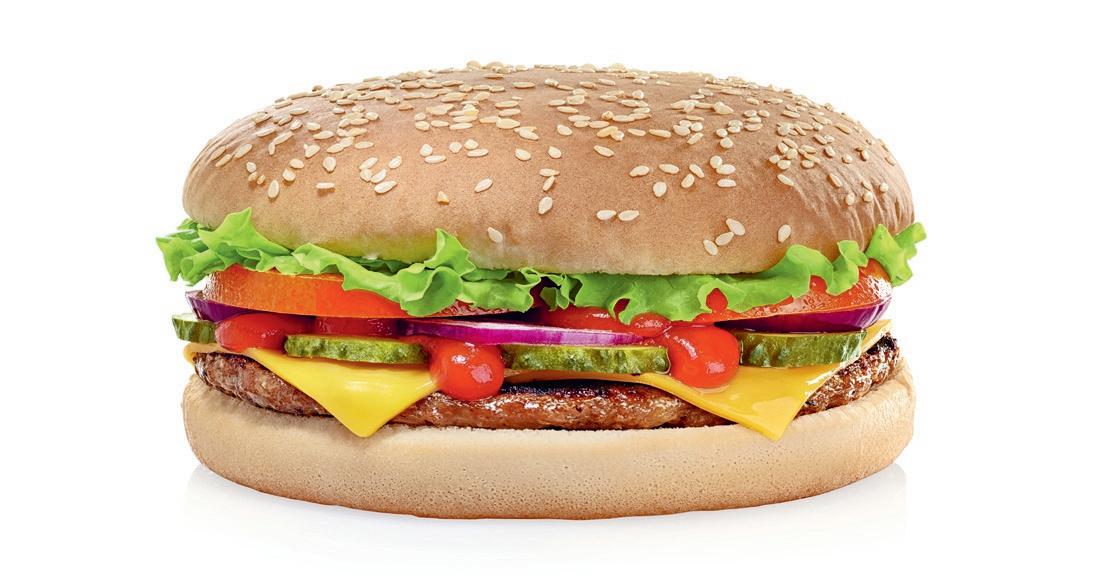
How well does it introduce the main idea?
Does it tell the reader what to expect in the essay?
Does it tell the reader about how the ideas are organised?
a) Check the introduction below using the questions in the checklist above.
Helping people is an important pursuit. There are many different ways I can help other people. Some of these I can do alone and others involve other people.
In this essay I will write about how I can help people, and which ways I feel are the most important.
b) Improve the introduction below using the checklist.
I am inspired by nature. I like walking in the woods, swimming in lakes, picking berries, and dancing in the falling leaves. I don't like skiing

There are so many different ways I am inspired by nature.
c) Using the text above, write a new, improved paragraph. ________________________________________________________________________________ ________________________________________________________________________________ ________________________________________________________________________________ ________________________________________________________________________________ ________________________________________________________________________________ ________________________________________________________________________________
d) Show the paragraph to a partner or another pair. Does it meet the introduction checklist criteria?
How well does it summarise the ideas in the essay?
How well does it tie all of the ideas together?
a) Read the conclusion below. Use the checklist above to check the conclusion. Discuss with a partner.
In this essay I have written about ways to help people. I have found many ways to help people, including sharing the things I have and teaching others what I know. However, I can’t do it alone. By helping each other, we will make a better world.
b) Improve the conclusion below using the checklist above.
I think a good person is one who is generous, kind, grateful, open, and a good
friend. There may be many opinions about what a good person is. What I am
sure we can all agree on is that a good person cares about others.
c) Write a new, improved paragraph based on the paragraph above. ________________________________________________________________________________ ________________________________________________________________________________ ________________________________________________________________________________ ________________________________________________________________________________ ________________________________________________________________________________ ________________________________________________________________________________
d) Show it to a partner or another pair. Peer assessment: Does it meet the conclusion checklist criteria?
3.6 My place in the universe – essay (See Textbook pages 44–45)
Have you ever thought about your place in the universe?
Write an essay about one of the following topics:
• Should we leave more room for animals?
• Is the earth overpopulated?
• Are manmade things more impressive than natural things?
• Should we become more urban?
a) Choose your essay topic.
b) Brainstorm your ideas for your essay. Use the questions on Textbook pages 44–45 to get your ideas flowing.
c) Create an outline to organise your ideas on the lines below.
A Identify your 3 main ideas. These are your paragraphs.
B For each paragraph, break down your main idea into 3 supporting points.
C Write keywords for each supporting point.
Introduction (Hint: what the text is about and how it is organised)
• _____________________________________________________________________________
• _____________________________________________________________________________
• _____________________________________________________________________________
Paragraph 1 (Hint: your first main idea or topic)
• _____________________________________________________________________________
• _____________________________________________________________________________
• _____________________________________________________________________________
Paragraph 2 (Hint: your second main idea or topic)
• _____________________________________________________________________________
• _____________________________________________________________________________ • _____________________________________________________________________________
Paragraph 3 (Hint: your third main idea or topic) •
Conclusion (Hint: short summary of the text and a solution/main opinion to tie the ideas together)
________________________________________________________________________________ ________________________________________________________________________________
d) Write your text, either on a digital device or on paper.
e) Afterwards, use the checklist below to self-assess your essay.
A Check the introduction.
How well does it introduce the main idea?
Does it tell the reader what to expect in the essay?
Does it tell the reader about how the ideas are organised?
B Check the conclusion.
How well does it summarise the ideas in the essay?
How well does it tie all the ideas together?

See Textbook pages 60–61 for support.
Read the definition of the word wealth. Is wealth different from being rich? Are there ________________________________________________________________________________ ________________________________________________________________________________ ________________________________________________________________________________
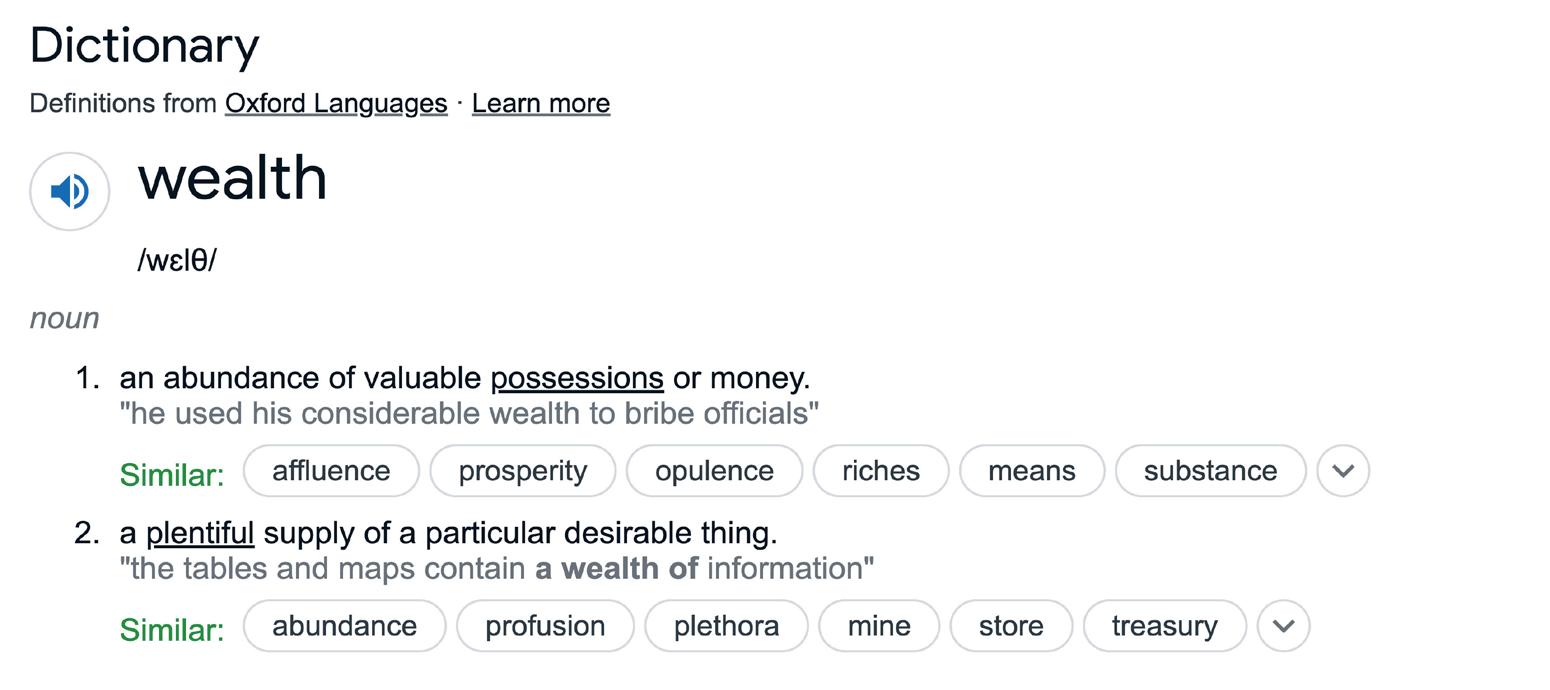
3.8 Use different sources to create your own definition of the word “wealth”.
________________________________________________________________________________ ________________________________________________________________________________ ________________________________________________________________________________
3.9
a) Ask people in your class: With whom do you eat breakfast? Make one mark for each student.
Tally marks
Alone
With my family
With my friends
Not at all
b) Make a chart. See Textbook pages 48–49 for support.
3.10
a) Ask people in your class: Where do you eat breakfast?
Where Tally marks
In my room
In the kitchen
In the living room
On the go
Other places
Not at all
b) Make a chart. Choose a pie chart or a bar chart.
What information is shown in your graphs? How is it shown?
Good morning. Terrible weather today, isn’t it? Good morning.
Yes… terrible weather, indeed. I hope it will pass soon.
b) When do you think it is common to engage in small talk? ________________________________________________________________________________ ________________________________________________________________________________ ________________________________________________________________________________
c) Can you think of any other topics that would be common for small talk? Write them down. ________________________________________________________________________________ ________________________________________________________________________________ ________________________________________________________________________________

Terry, I haven’t seen you for a while! How are you?
I’m fine, thanks.
b) Can you think of any expected responses to “How are you?”? Write them down. ________________________________________________________________________________ ________________________________________________________________________________ ________________________________________________________________________________
c) Can you think of any other ways you can greet people in English? Write them down.
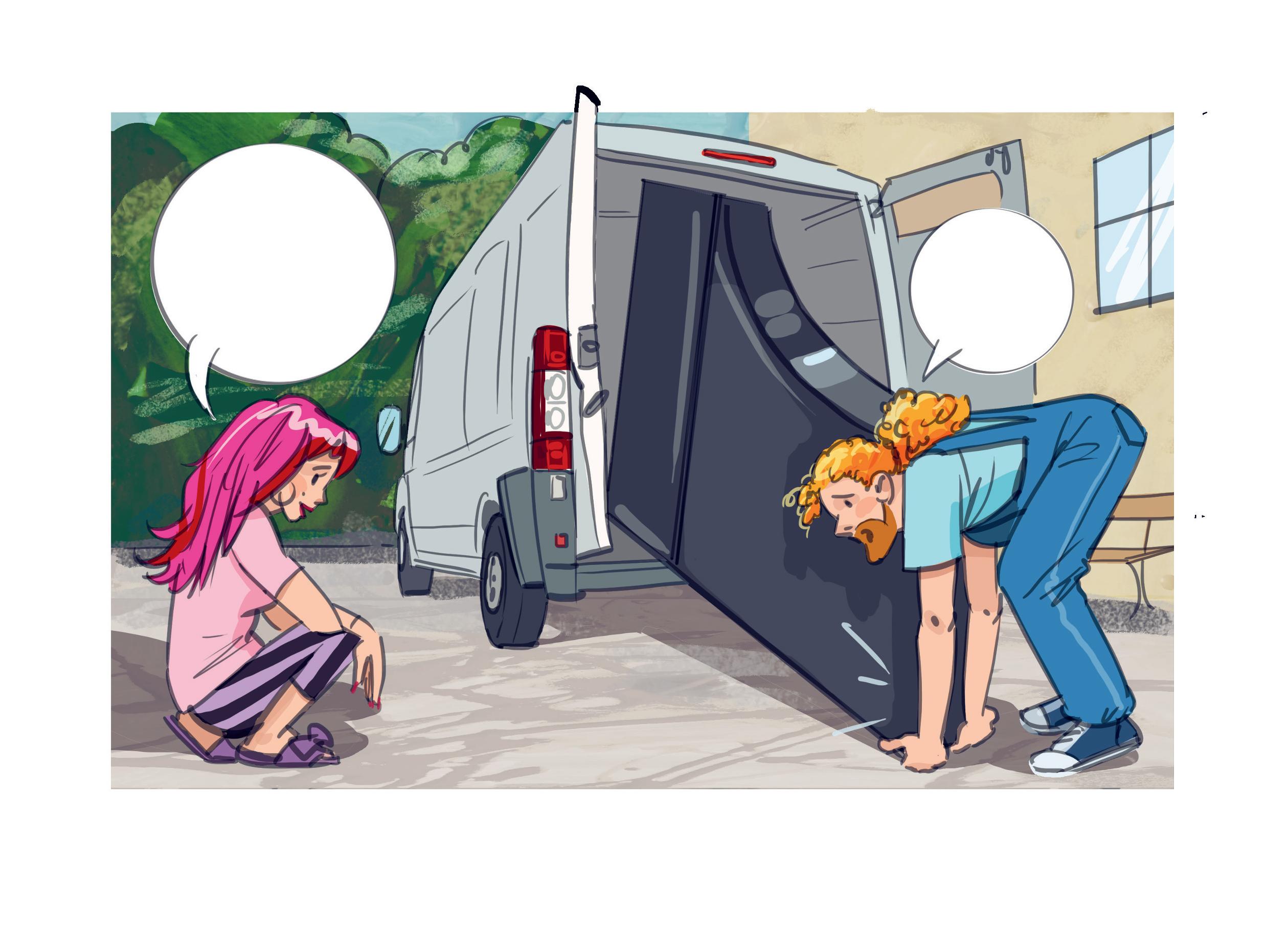
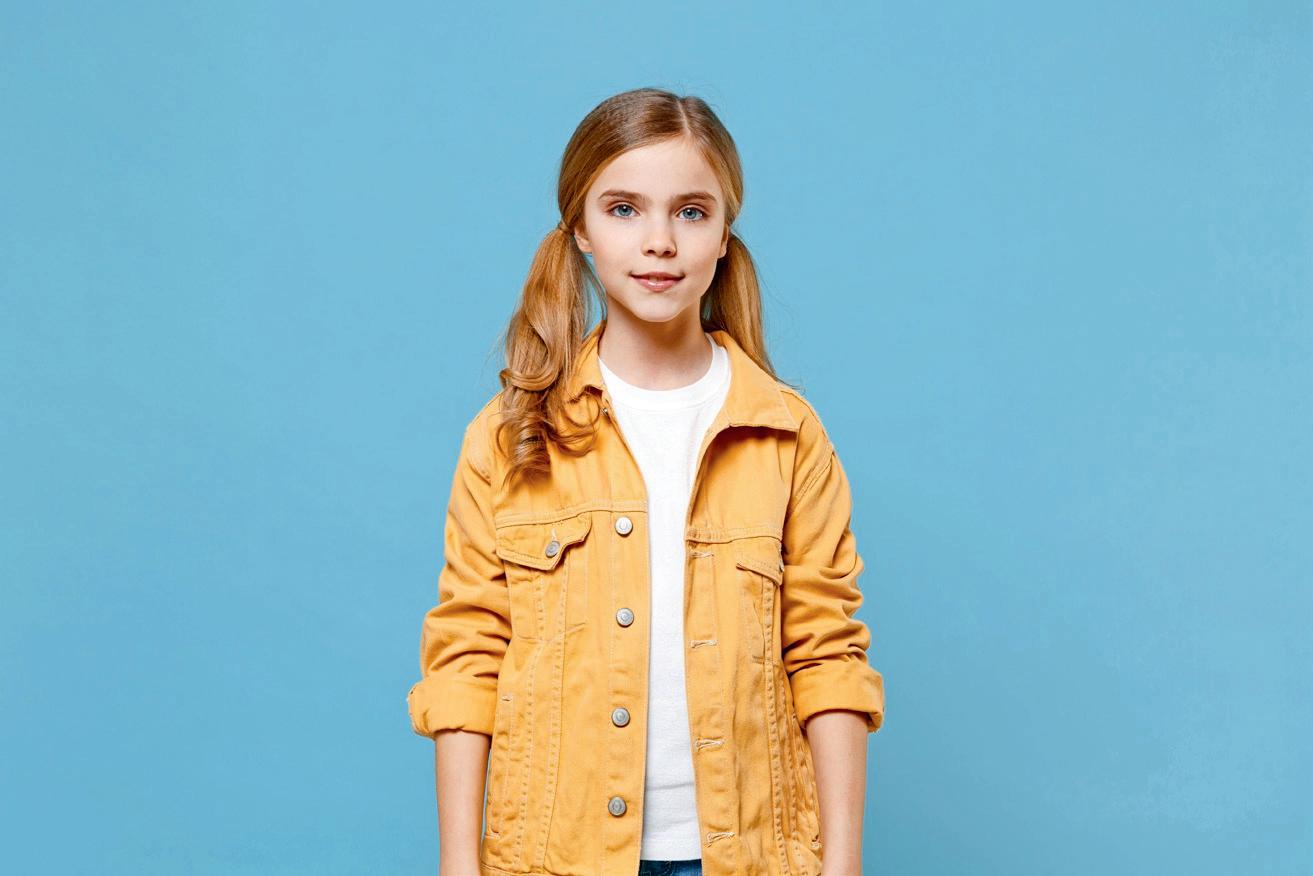
Maja, Aida, Mike, and Abid have all moved from one place to another. Listen to their reasons for moving.


Summarise their reasons in one sentence for each person.

I can use a varied vocabulary.
Choose one or two texts you have read in this chapter. Pick out four words from the text(s) and write them in the column to the left. Find synonyms for these words. Look them up in a thesaurus.
I can use multiple sources to create my own text.
Choose one of the texts you have written in this chapter. Which sources did you use? For example books, Internet pages, people etc.
I can write topic sentences for a paragraph.
Choose a topic sentence you have written. Write it down and share it with your learning partner.
___________________________________________________________________________
I can investigate different ways of living in my own and other societies.
What is important to you in your life? Prioritize these:
Money
Friends and family
Physical health
Mental health
Spare time
Education
Compare with your learning partner. What is the same? What is different? Why did you answer as you did?
serious
happy
understanding
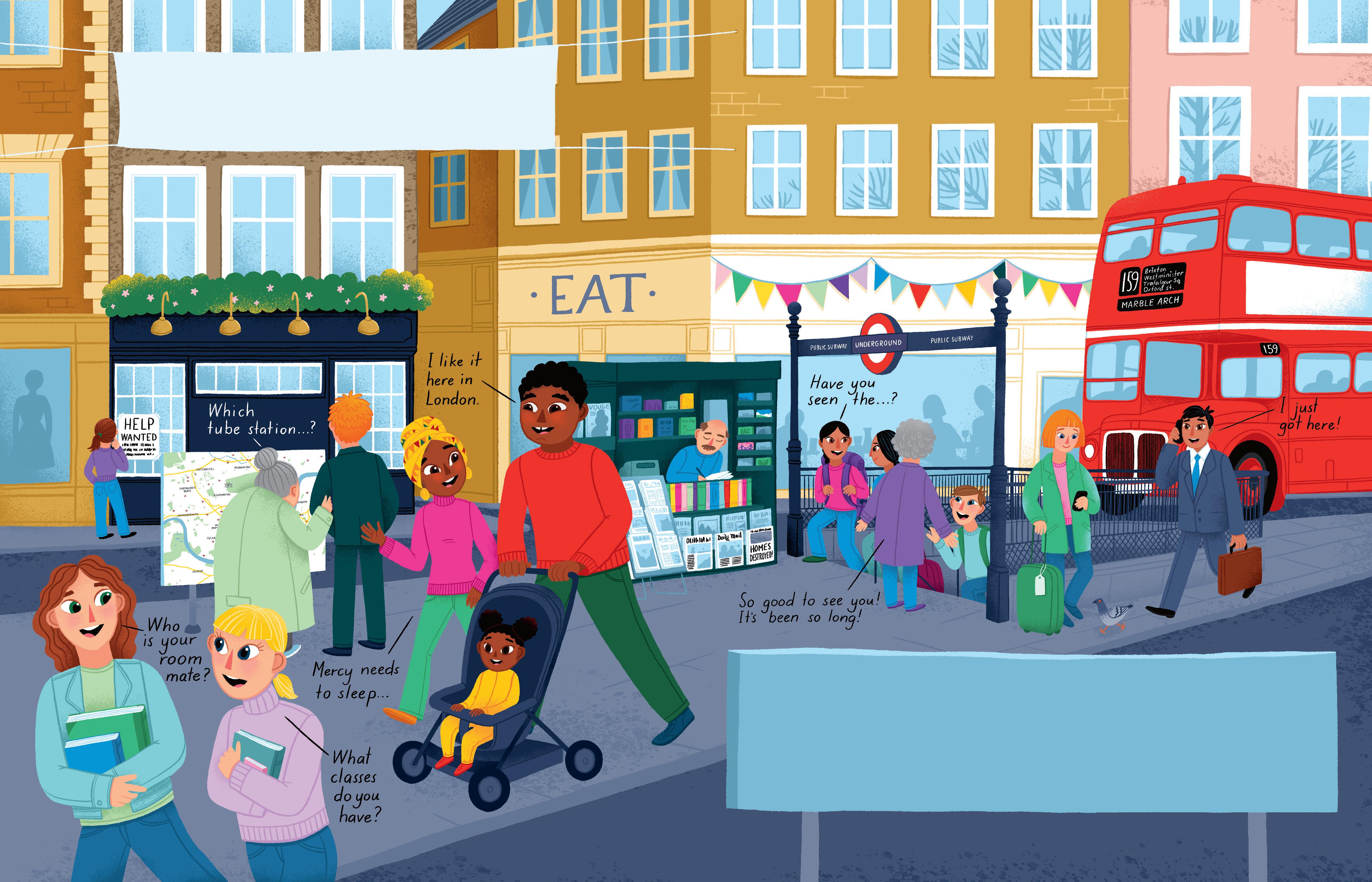
anxious shocked hopeful
surprised miserable encouraging angry sad
apologetic
Across
2 no joke, grave, important
4 amazed, shocked, speechless
6 sorry, regretful, red-faced
8 jolly, glad, merry
9 optimistic, positive, reassuring
10 considerate, sensitive, forgiving
1 downhearted, unhappy, sad
2 stunned, flabbergasted, startled
3 unhappy, gloomy, sorrowful
5 supportive, comforting, hopeful
6 cross, annoyed, irritated
7 worried, nervous, concerned
Antonyms are words that mean the opposite. Draw a line to the word with the opposite meaning.

Look up the words you don’t know or are curious about.
serious
anxious
carefree, unconcerned
remorseless, shameless
casual, nonchalant surprised happy
angry
apologetic misunderstanding shocked unimportant
sad joyful, optimistic miserable pessimistic understanding sad hopeful
indifferent, unimpressed happy discouraging encouraging good-humoured
Find 10 adjectives in the word search. They are either horizontal or vertical, no diagonals. Write them down and find the antonyms. Use a dictionary if you need to.
What would you miss if YOU moved away?
4.4 Talk to your learning partner about what you read about in the text “Happiness doesn’t have just one address” on pages 70–72 in Textbook. Make notes while you are summarising.
Imagine you were to move to another place, city, or country.

– What would you miss?
– What might be different?
– What might be better?
See Textbook pages 211–212 for support.
Find keywords. Write a personal text like a diary, blog, or letter. Use your keywords to express your experiences through your writing. Write your personal text on a digital device or by hand.
A written, typed or printed form of communication, sent by post or online.
A book in which one keeps a daily record of events and experiences. It can be private, like a diary, or public, like a blog.
Read the sentences and focus on the words highlighted in green and yellow.
Mum has told me that she has to move away for work for a while. Her company is setting up a new office in Mexico, and she will have to stay there for 7 months.
Okay, so I’m still thinking.
I wonder if dogs are allowed to run freely in the forest in Canada.
I’ve never lived alone with Dad. Will it be the same as when I've been there on vacation? How’s school in Canada anyway? Uniforms?! School lunches? More homework than I have now? Long lessons?
I just spoke to Grandma. She’s SO excited that I’m moving to Canada.
a) Which word class do the green words belong to?
A nouns
B verbs
C adjectives
b) Which word class do the yellow words belong to?
A nouns
B adjectives
C adverbs
c) Write new sentences with the words highlighted in yellow.
4.7 Challenge: Find and mark all the nouns and adjectives in task 4.2
An adverb is a word that modifies or describes a verb.
See Textbook pages 76–77.
1 Where is James’s mother going?
X: to Canada Y: to Mexico Z: to New Zealand
2 How long will James’s mother stay there?
N: for twelve months O: for six months P: for seven months
3 Which day did James write pros and cons about moving?
U: Wednesday V: Saturday W: Tuesday
4 What was James’s dad’s suggestion when James spoke with him on the phone on Tuesday?
R: James should go to Mexico with his mother. S: James should stay with his grandparents in Norway. T: James should come and live with him in Canada.
5 Which day of the week did James decide to move to his father?
R: Tuesday S: Saturday T: Wednesday
6 Which month is James going to move to Canada?
R: January S: February T: March
7 What is James’s uncle’s name?
M: Charlie N: Henry O: Jonathan
8 What will Charlie do when James moves to Canada?
M: Charlie is going to Canada too. N: Charlie is staying with James’s grandparents. O: Charlie is going to Mexico with James’s mother.
9 “I wonder if dogs are allowed to run freely in the in Canada.”
I: woods J: parks K: forest
10 Which of James’s friends has been in Canada with him?
I: Jonathan J: Aryan K: Mercy
11
How many times has James’s friend been to Canada with him?
E: once F: twice G: thrice
12 What is James’s aunt’s name?
C: Thea D: Emma E: Charlotte
13 Where will James celebrate Christmas?
C: in Norway D: in Canada E: in Mexico
14 I just spoke to Grandma. She’s SO that I’m moving to Canada.
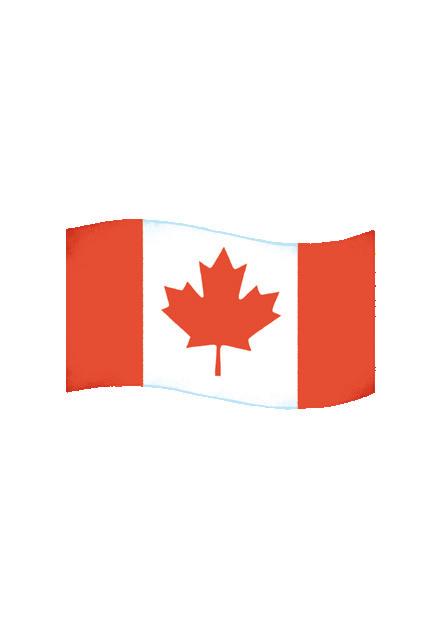
A: happy B: excited C: joyful
15
Which day did James tell his friends that he is moving?
A: Sunday B: Wednesday C: Saturday
16
How many times do you find the word “Mexico” in the text?
F: once G: twice H: thrice
17 How many times do you find the word “school” in the text?
F: once G: twice H: thrice
Why is maple syrup always so sad?
What does Canada produce that no other country in the world can?
Why shouldn’t hockey players tell jokes on the ice?
a) Before you came to Norway, have you always lived in one place? ________________________________________________________________________________ ________________________________________________________________________________
b) What made you decide to move so far from home? ________________________________________________________________________________ ________________________________________________________________________________
c) Based on your experiences here, what was similar to what you expected? ________________________________________________________________________________ ________________________________________________________________________________

d) Based on your experiences here, what was dissimilar to what you expected? ________________________________________________________________________________ ________________________________________________________________________________
e) Would you consider migrating to another country later in life? Why or why not?
a) Talk to one or two of your classmates about
– who they live with
– how they live (house, flat etc.)
– their interests
b) Fill out this Venn diagram for you and your classmates.
name: ____ __________
name:
name:
A commonly held stereotype is that the British are more polite than Norwegians, but where does this come from? Is there anything in the languages or behaviours that make people seem polite or impolite to others?
a) What in the English language do you think makes the British seem polite to Norwegians? You can write down specific words and phrases, behaviours, or other thoughts.
b) What in the Norwegian language do you think makes Norwegians seem impolite to the British? For example, are there any words or phrases in Norwegian that you think are impolite?
a) Are there any words and/or phrases in the English language that are polite? Write them down.
b) Look at your list of polite words and/or phrases. Could they be used in a situation where they are impolite? Choose one word or phrase and create a scenario in which it is not used in a polite way.
a) See page 92 in Textbook. Can you think of other stereotypes about Norwegians? Start each sentence with It’s typically Norwegian to…
b) Look at the stereotypes you wrote above. Do the stereotypes apply to you? Why / Why not?
c) Look at the stereotypes you wrote above. Find someone (for instance in class, in school, at home, or in your neighbourhood) that does not fit the stereotype. Can you find a Norwegian who does not love cross-country skiing? You may have to find different people for each stereotype. Who did you find?
Start each sentence with the person’s name and include the stereotype that they do not fit, for example Jonathan does not love-cross country skiing.
It’s typically Norwegian to love cross-country skiing.
See Textbook page 211 for criteria for a factual text.
This is one way to write a factual text.
Choose economic migration, social migration, political migration, or environmental migration and write an outline for a text. See page 73 in Textbook for inspiration.
Factual text title:
Introduction: ____________________________________________ __________________________________________________________
I can find and evaluate sources.
I can name or list the sources I have used.
Topic 1 ___________________________________________________________________________________
Facts for topic 1. Write keywords. ___________________________________________________________________________________ ___________________________________________________________________________________ ___________________________________________________________________________________ ___________________________________________________________________________________ ___________________________________________________________________________________
Sources: ___________________________________________________________________________________ ___________________________________________________________________________________ ___________________________________________________________________________________
Topic 2
Facts for topic 2. Write keywords.
4.15 Use your outline to write a factual text. Use a digital device or write it by hand. Remember to list your sources.
4.16 See Textbook pages 78–79 and find facts. Find more
I can summarise the content of a text I have read.
Choose one of the texts you have read in this chapter, for example From the Tops of the Trees on pages 80–87 or Making a life on pages 88-91 in Textbook.
Write down at least six keywords from the text. Then talk about the text with your learning partner. Use the keywords for support.
Title of the text: __________________________________________________________________
Keywords: ______________________ ______________________ _______________________ ______________________ ______________________ _______________________
I can find and evaluate sources.
Choose one of the factual texts you have written in this chapter or earlier this school year. Which source(s) did you use and where did you find them? ________________________________________________________________________________
Why did you choose this/these source(s)? ________________________________________________________________________________
I can name or list the sources I have used.
Choose one of the texts you have written in this chapter. Which sources did you use? For example books, Internet pages, people etc. ___________________________________________________________________________ ___________________________________________________________________________
I can compare my own way of living with others’ way of living.
Talk to your learning partner. Have you ever moved? Has anyone in your family ever moved? Do you think you will move to another place or country when you grow up? Why, or why not? Why do you think some people move often? Why do you think some people never move?
I think it means… In my opinion… On the one hand… on the other hand
For instance
Sometimes
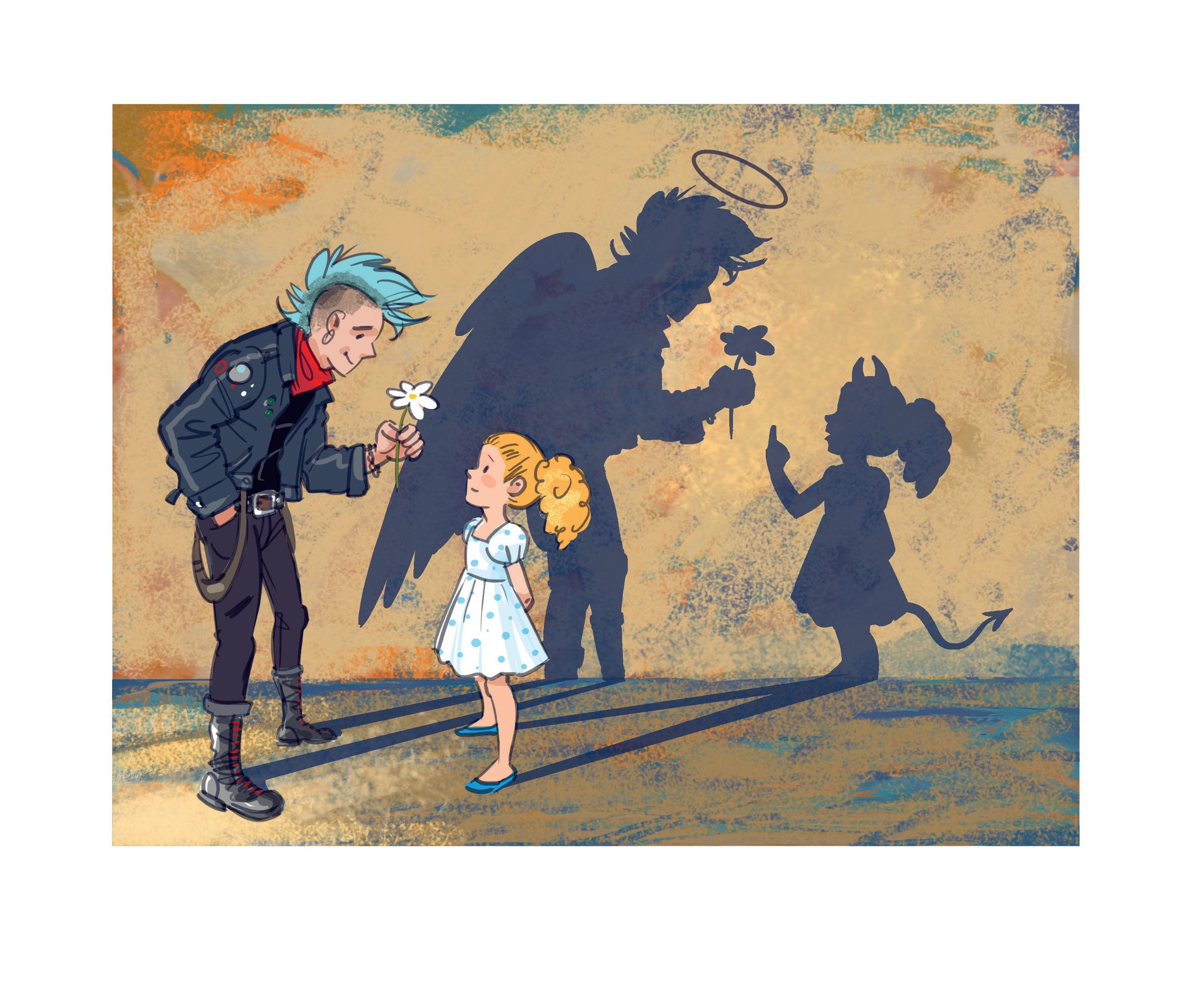
5.3 “Don’t judge a book by its cover” is another saying. What do you think that means? Explain the saying using your own words.
5.4 Try to illustrate the meaning of the saying “don’t judge a book by its cover”. Look at the illustrations for support.
5.5 In what ways might we “judge a book by its cover?” Write examples.

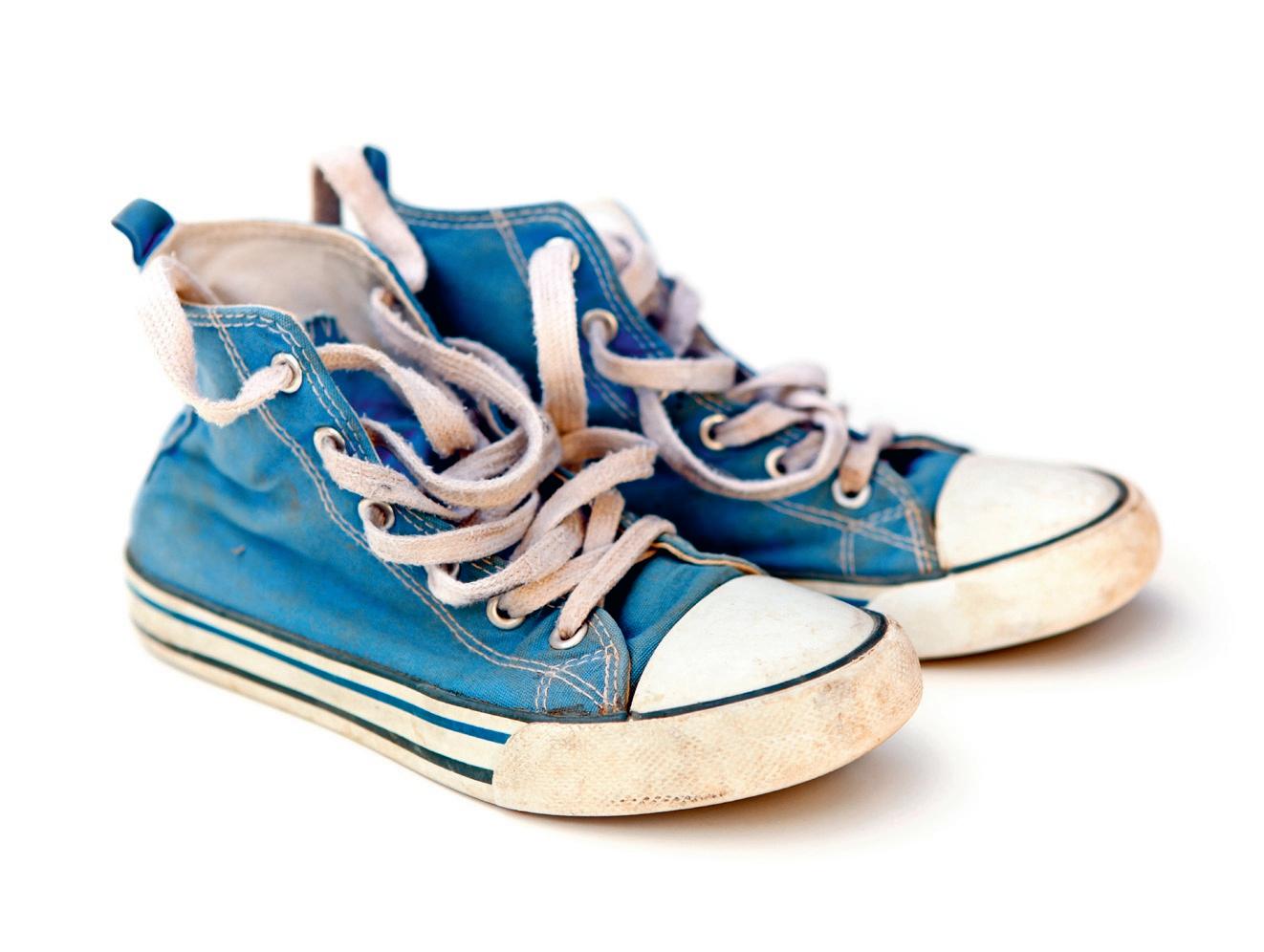 By Joe South
By Joe South
If I __________________ be you
And you could __________________ me
For just one __________________
If we could __________________ a way
To __________________ inside
Each other’s __________________, mm-hmm
Listen to the song and fill in the missing words. You may listen to the song more than one time.
Chorus a mile in my shoes
Walk a __________________ in my shoes
Hey, before you __________________
Criticize and __________________
Walk a mile in my __________________
If you could __________________ you
Through my __________________
Instead of your __________________
I believe you’d __________________
Surprised to __________________
That you’ve been __________________, mm-hmm
Now, your whole
You around you Is just a And the law of __________________
Says you’re gonna __________________
Just what you ______________, yes you will
So unless You’ve a life
Of total
You better __________________ careful
Of every __________________
That you should __________________ yeah
And yet we __________________ the day
Throwing __________________
At one another
’Cause I don’t _________________________
Or wear my __________________
Same way you __________________, mm-hmm
There are __________________
On __________________
And out in the __________________
And __________________, there
But for the __________________ of God
__________________ you and I, yeah, yeah
Well, I may _________________________
Common __________________
But I’m your __________________
And when you __________________ out
And try to __________________ me
It’s hurtin’ you, Lord __________________ mercy
And if I only
Had the __________________
Of a little __________________, yeah
Don’t you know I’d __________________
To the top of the __________________
Chorus
And then I’d __________________, hey Chorus
The words that you have filled in belong to two word classes. What are these word classes called?
Answer: __________________ and __________________
Some parts of your identity are on the outside and can easily be identified, such as your clothes or your languages. Other parts are more hidden, like your believes, your fears or your sense of humour.


a) Write down four sentences about yourself, one of them has to be false.
b) Have your learning partner guess which one is fake. __________________________________________________
Example: My favourite colour is orange.
Example: I prefer classical music.
Take a look at your sentences again. Which ones of these can be easily identified just by looking at you, and which ones are more hidden?
Do you think you can tell a lot about a person just by looking at them? Why or why not?
Discuss with your learning partner.
There is a joke based on stereotypes that goes like this:
In Heaven, the cooks are French, the policemen are English, the mechanics are German, the lovers are Italian, and the bankers are Swiss. In Hell, the cooks are English, the policemen are German, the mechanics are French, the lovers are Swiss, and the bankers are Italian.
a) What do you think this joke says about the French?
b) What do you think this joke says about the English?
c) What do you think this joke says about the Germans? ________________________________________________________________________________ ________________________________________________________________________________
d) What do you think this joke says about the Italians? ________________________________________________________________________________ ________________________________________________________________________________
e) What do you think this joke says about the Swiss? ________________________________________________________________________________ ________________________________________________________________________________
a) There are also stereotypes about boys and girls. Have you ever seen toys that are aimed to be sold to boys or to girls? List them below.
b) Choose 1 of the toys for boys from your list. Why do you think this toy is considered to be mainly for boys? ________________________________________________________________________________ ________________________________________________________________________________
c) Challenge the stereotype. Do you know any girls who like to play with the toy you chose? ________________________________________________________________________________ ________________________________________________________________________________
d) Choose 1 of the toys for girls from your list. Why do you think this toy is considered to be mainly for girls? ________________________________________________________________________________ ________________________________________________________________________________
e) Challenge the stereotype. Do you know any boys who like to play with the toy you chose? ________________________________________________________________________________ ________________________________________________________________________________
5.10 Where do stereotypes come from?
a) Some examples of stereotypes about boys and girls are:
Girls are better at reading than boys
Girls are quieter than boys. Maths and physical education are boy subjects.
Boys are better in sports than girls. Boys like to play with cars.
Girls like to play with dolls. Boys like to play computer games.
Girls do not like to play computer games.
Where do you think these stereotypes come from? ________________________________________________________________________________ ________________________________________________________________________________
b) Pick 1 of the stereotypes above. Do you think this stereotype can be hurtful? Why / Why not? ________________________________________________________________________________ ________________________________________________________________________________
c) Challenge the stereotypes. Choose 3 stereotypes from the list and find a person who does not fit the stereotype. For instance, do you know a girl who likes to play computer games, or a boy who doesn’t like to play with cars? List them below. For example, Jonathan does not like to play with cars. ________________________________________________________________________________ ________________________________________________________________________________ ________________________________________________________________________________
d) When you can find people who do not fit their stereotype, what do you think it says about stereotypes? ________________________________________________________________________________ ________________________________________________________________________________
This task starts in Textbook page 106 with the sentence “Unhei stood in the doorway of her new and noisy classroom.” The verbs come in the same order as in the text.
Find a verb that…
…has five letters, two o’s, and starts with s. _________________________________
…has four letters and starts with f. _________________________________
…has five letters, ends with -ed, and starts with a. _________________________________
…has six letters, three d’s, and starts with n. _________________________________
…has four letters, two o’s, and starts with t. _________________________________
…has six letters and is the opposite of pushed. _________________________________
…has nine letters, ends with -ed, and starts with a. _________________________________
…has seven letters, two d’s, and two p’s. _________________________________
…has seven letters, ends with -ed, and starts with th. _________________________________
…has four letters and is DISA scrambled. _________________________________
…has seven letters and is the opposite of departed. _________________________________
…has six letters and is DIMLES scrambled. _________________________________
…has five letters, two vowels, and three consonants. _________________________________
…has seven letters and is the opposite of whispered. _________________________________
5.12 Sort the verbs that you have found. See Textbook pages 202–203 if you want to.
5.13 Write new sentences with the verbs above. ________________________________________________________________________________ ________________________________________________________________________________ ________________________________________________________________________________ ________________________________________________________________________________ ________________________________________________________________________________ ________________________________________________________________________________ ________________________________________________________________________________
Challenge: Choose 4 or more of these verbs and write a short story / news report / fairy tale…
It is important to give credit to sources we use. We cannot steal other people’s ideas. However, we can share their good ideas, if we share whose ideas they are and where we have found them. (In other words, if we reference them.)
I can name or list the sources I have used.
We can quote, or we can paraphrase – that means write it in our own words. Either way we need to say where we got the ideas (reference the source).
Here are some examples:
Food is important for our bodies. There are many types of food, but they are all made up of things our bodies need (Singh, 2020). Our bodies need carbohydrates, fat, and protein. “Depending on where you are from, you might eat different things. But you still need to make sure your diet is balanced” (Singh, 2020, page 21). In other words, we should eat many different types of food, and not too much of each one, to be healthy.
Amanda Gorman is a rolemodel for young people. Amanda writes about many challenging topics including violence, racism, and discrimination. She also writes about change, hope and bravery (Olsen, no date). Amanda was a National Youth Poet Laureate (poets.org).

"Amanda Gorman". Poets.org. Retrieved May 12, 2023 from poets.org/poet/amanda-gorman. Olsen, Joey. (no date) "Welcome back to my blog!" Youngsters to admire. Retrieved May 15, 2023 from youngsterstoadmire.blogging.com
When we give credit we need to refer to the author by listing the web address, or the author’s name, the name of the book, the publisher, the place it was published, and when it was published. If we don’t know, we write the information we have.
5.14 Write a paragraph on a topic below and reference your sources.
a) Choose one of the following topics:
– A country
– An animal
– A sport
b) Learn about your topic using books, the internet and other sources. Find at least 2 sources and list them below. Find one direct quote. Find three facts that you paraphrase (or you can write in your own words). Reference the source for each in the text and at the end of the text.
Source 1: ________________________________________________________________
Title: ____________________________________________________________________
Author: __________________________________________________________________
Publisher/Where it is published: ______________________________________________
Year/Date: _____________________
Source 2: ________________________________________________________________
Title: ____________________________________________________________________
Author: __________________________________________________________________
Publisher/Where it is published: ______________________________________________
Year/Date: _____________________
c) Write a paragraph using your quote and paraphrases. Write your paragraph on a digital device or by hand.
5.15 Can you find hints about what the people are trying to communicate?
a) Woman talking to her child: “So here you are, in a big mess… Well, I’m all ears!”
What is the woman talking to her child trying to say? _____________________________________________________________________________ _____________________________________________________________________________
b) A girl is visiting her friend’s house on a hot summer day. Suddenly she says: “Whoa, I’m so thirsty!”
What is the visiting girl trying to say to her friend? _____________________________________________________________________________
c) Man: “Hey kids, this hallway is really messy!”

What is the man trying to say to his kids? ______________________________________ _____________________________________________________________________________
d) Mom: So, are you sure you have everything you need in your bag?
Boy: Yes, everything is packed and ready!
Dad: Make sure your form “minor without a companion” is visible all the time, okay?
Boy: Okay, I will.
Mom: Here’s some gum, and some money if you get hungry on board.
Boy: Thank you. Don’t worry too much, you guys. I’ve done this before, you know? I’ll let you know when I get there.
Where are they, and what is happening? _____________________________________________________________________________ _____________________________________________________________________________
To “read between the lines” means to find hidden meanings from what is actually said and written. The term comes from cryptography, in which one kind of code actually presents a message on every second line. If you read every second line, it has quite a different meaning than if you read all of the lines.
When listening I can use audio and visual information to understand. When talking about the iceberg model on page 101 in Textbook, how did listening to your partner and looking at the visual information help you understand?
How do different types of text help you understand? Talk to your learning partner about how you learn.
I can read between the lines.
What does it mean to read between the lines? Discuss with your learning partner.
Choose a text you have read in this chapter, for example Read between the lines on pages 118–119 or There's more to this than meets the eye on pages 120–123 in Textbook. In what ways did you have to read between the lines in this/these text(s)? Talk to your learning partner.
I can use different types of texts to communicate information.
Which types of media did you use to communicate information in this chapter?
visual/pictures
text in a book
text on the Internet film
audio/sound
a mix of many media/types of texts: ________________________________________
Which media/types of texts do you prefer to use when you are learning something new? Talk to your learning partner.
I can talk about aspects of culture and identity that are easy to see and difficult to see.
Talk to your learning partner. What aspects of culture and identity are easy to see and what are difficult to see? Share an experience where something is difficult to see and why. See the iceberg in Textbook page 101.
Examples: At someone's house, in a bus line abroad, or using language.
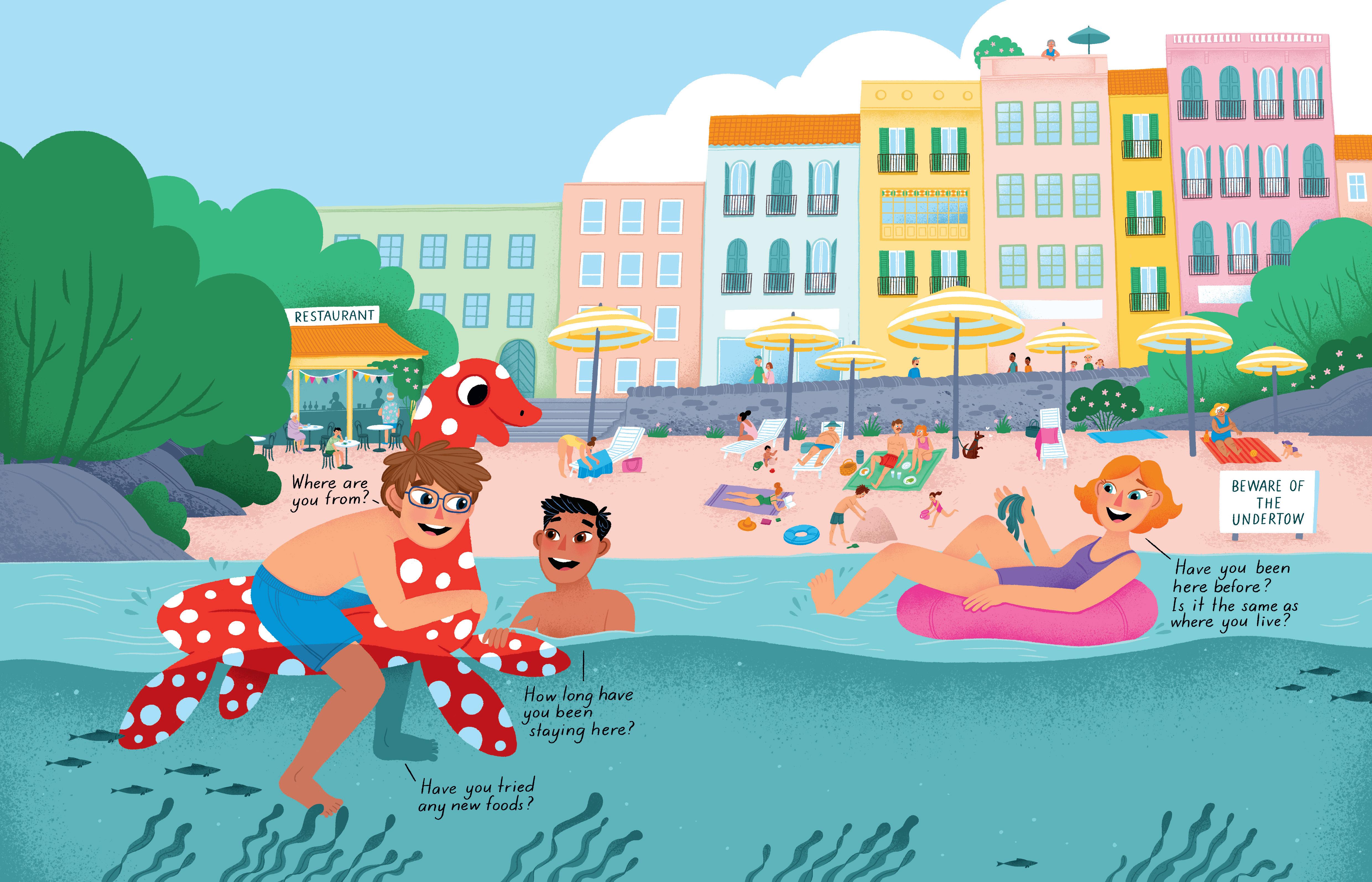
6.2 Make a list of where and how you can meet new friends. ________________________________________________________________________________ ________________________________________________________________________________ ________________________________________________________________________________ ________________________________________________________________________________ ________________________________________________________________________________ ________________________________________________________________________________ ________________________________________________________________________________ ________________________________________________________________________________
6.3 Make a list of topics you can talk about.
See Textbook pages 40–41 Spontaneous speech for inspiration. ________________________________________________________________________________ ________________________________________________________________________________ ________________________________________________________________________________ ________________________________________________________________________________ ________________________________________________________________________________ ________________________________________________________________________________ ________________________________________________________________________________ ________________________________________________________________________________
Tips for practising language with new friends: Find new friends online by playing games, using social media, or using communication channels.

Talk about family, your home country, a place you have visited, or interests you have.
Watch films/TV in your target language together.
What might be the advantages of knowing other languages?
6.4 Search the Internet. Find a pun you like.
To the guy who invented zero, thanks for nothing.
What does word play mean?
What does a “pun” mean?
What is it that makes you like this pun?
I like it because… I found it… In my opinion…
6.5 Make a pun (See Textbook pages 136–137 for inspiration)
6.6 Why might it be useful to understand English puns and word play? Share your answers with others.
A pun is a joke that makes a play on words through words and/or pictures. A pun often uses words that mean more than one thing or words that are similar to other words.
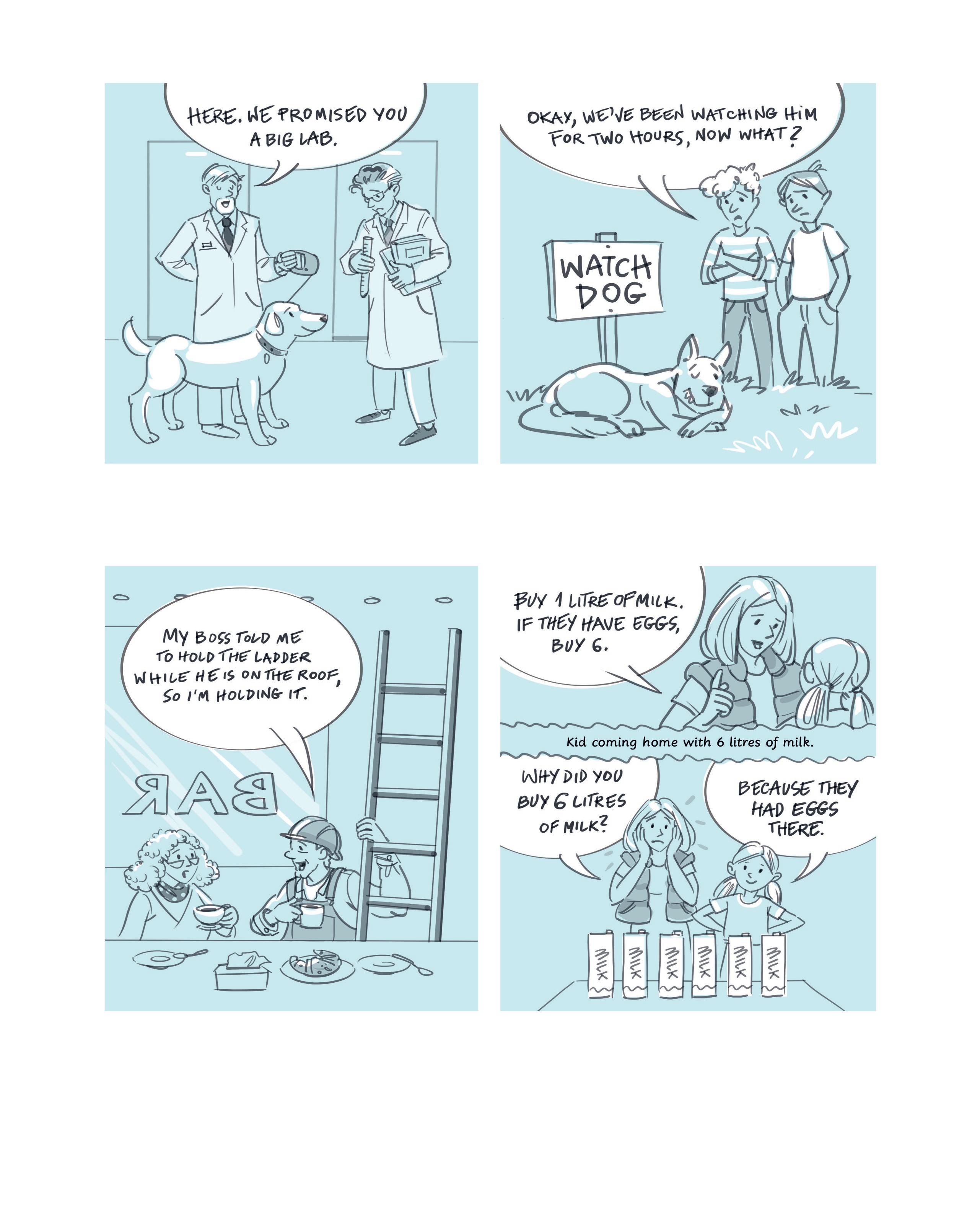
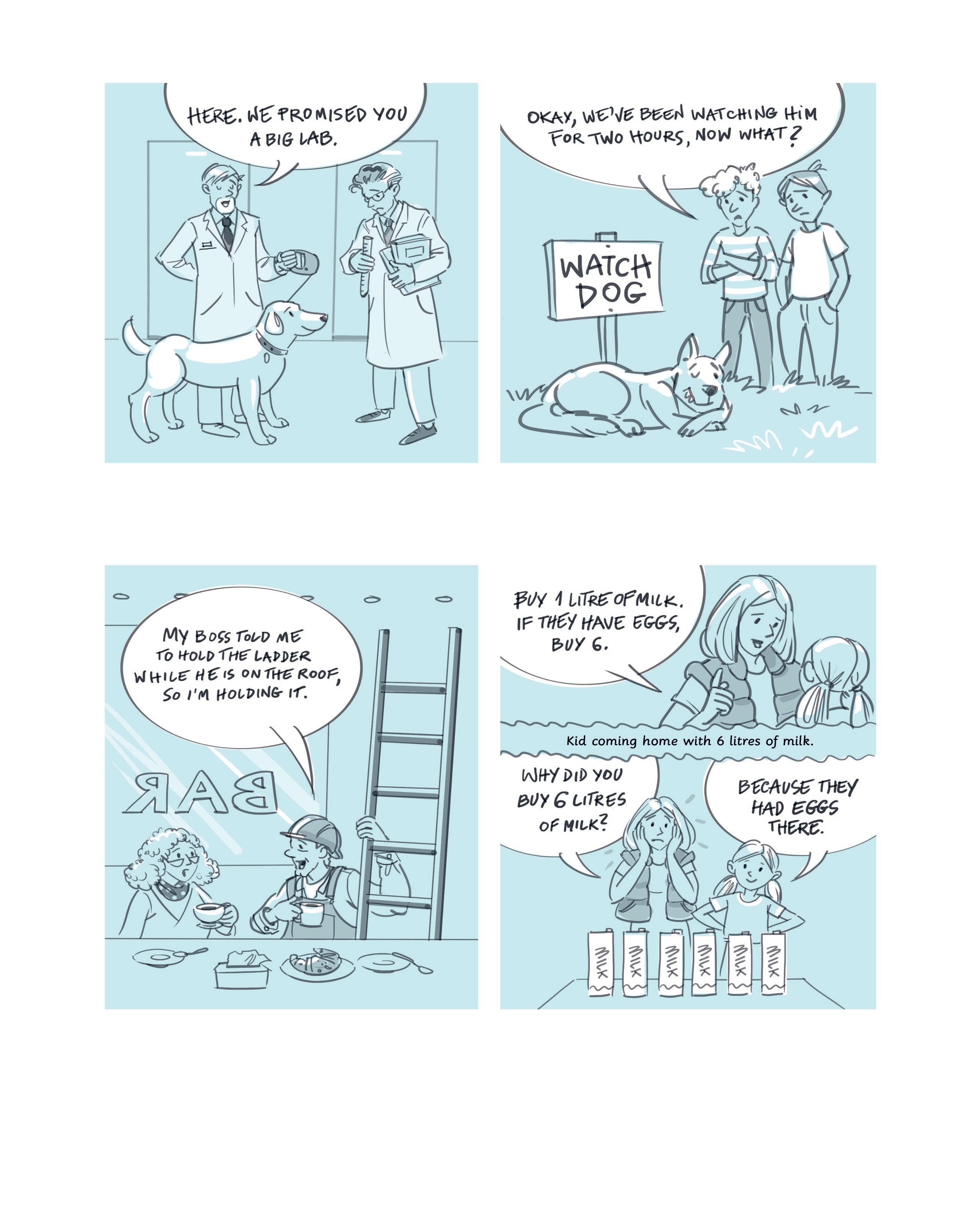
Which language do you think this is and why?
a) Gibt es ein Restaurant in der Nähe?
A Spanish B German C French
Why? ________________________________________________________________________
b) Y a-t-il un restaurant à proximité?
A Spanish B German C French
Why? ________________________________________________________________________
c) ¿Hay un restaurante cerca?
A Spanish B Italian C Greek
Why? ________________________________________________________________________
d) Er veitingastaður í nágrenninu?
A Swedish B Portuguese C Icelandic
Why? ________________________________________________________________________
e) Υπάρχει εστιατόριο κοντά; (Ypárchei estiatório kontá?)
A Russian B Greek C Hebrew
Why? ________________________________________________________________________
Compare the words in the sentences and mark words that are very similar and somewhat similar, in the different languages.
Red = Very similar, Blue = Somewhat similar
He is twelve years older than me. Han er tolv år eldre enn meg.
May we have some juice, please? Kan vi få litt jus, er du snill?
An essay is formed around a topic and a purpose for writing about that topic (thus we have different types of essays). Essays tell about or express an opinion about a topic. We can help the reader to understand our topic or our opinions about our topic when we link topics across paragraphs.
In an essay we need an introduction and conclusion, and each one is a paragraph. Between the introduction and conclusion, we write about the main ideas in different paragraphs.
Tools we use to link in and between paragraphs:
• Listing words: First, second, finally
• Linking words: All of these examples, while, for example, in addition, yet, then

• Topic sentences that connect to the previous paragraph
• Repeating words from one paragraph to another
6.10
a) Read the paragraphs. Find the correct order. Place numbers 1–5 next to each of the paragraphs.
Second, they each presented their arguments for their favorite. Mercy wanted rock climbing because she thinks they all need a challenge and it could be fun to be up high. Aryan wanted swimming because he thinks it will be hot this summer and they will need to cool off. Jonathan selected canoeing because they can work in teams to paddle around the lake. Thea chose horseback riding because she misses her aunt and uncle's farm.
Finally, after voting, they tallied all the votes. The results were 2 votes for rock climbing, 3 votes for canoeing, and 1 vote for swimming. This means that they have agreed to do canoeing and rock climbing. In addition, they can do many other things together during free time. All in all, they are sure this will be a great summer.
First, they looked over the alternatives. They could choose between eight activities. They decided they would each decide on their favorite and come up with a good argument to persuade the others. The activities were: swimming, horseback riding, pottery, archery, wilderness survival, canoeing, rock climbing, and orienteering. All of these activities sounded exciting, but they had to choose.
Mercy and her friends are planning for Scout camp next summer. They looked at the list of different activities they could choose from. They decided it was most important for them to be in at least two activities together. However, how will they choose?
After listening to the arguments, they decided to vote on which activities to choose. Each of the friends could vote on their top two favorites. For example, one person could choose swimming and rock climbing. Yet they could not choose them all. Who had been most persuasive?
b) How did you know which is the right order?
c) Underline the linking words in the text.
d) Use the words in a text of your own.
e) Choose a text you have written. Find and highlight or circle the linking words you have used. Check off in the list below which ways you link ideas across paragraphs in your text. Ask a partner for help.
I show how the ideas in one paragraph connect to another using linking words (conjunctions, linking adverbials, and/or time adverbials).
I use repetition to show how the ideas in one paragraph connect to another.
I use topic sentences to begin paragraphs to show what is in the new paragraph and connect to the ideas in the previous paragraph.
6.11 Write a persuasive text.
A persuasive text is a text that tries to persuade or convince others to do or believe something.
a) Prewriting activity (find and use different sources to answer the questions below.)
– Which languages do you use? _____________________________________________________________________________ _____________________________________________________________________________ _____________________________________________________________________________ _____________________________________________________________________________
– In your opinion, in what ways are languages and language learning important? _____________________________________________________________________________ _____________________________________________________________________________ _____________________________________________________________________________ _____________________________________________________________________________
– What are the advantages of knowing different languages? _____________________________________________________________________________ _____________________________________________________________________________ _____________________________________________________________________________ _____________________________________________________________________________
b) Plan your text by organising your ideas into an outline. Write the ideas using keywords. _____________________________________________________________________________ _____________________________________________________________________________ _____________________________________________________________________________ _____________________________________________________________________________ _____________________________________________________________________________
c) Write your persuasive text. Make sure the ideas in the text are well connected, using linking words.
– Introduction – what the text is about. _____________________________________________________________________________ _____________________________________________________________________________ _____________________________________________________________________________ _____________________________________________________________________________
– Arguments for and against – with “evidence” to support the arguments. _____________________________________________________________________________ _____________________________________________________________________________ _____________________________________________________________________________ _____________________________________________________________________________
– Conclusion – make a short summary of the text, give your opinion, and suggest a solution. _____________________________________________________________________________ _____________________________________________________________________________ _____________________________________________________________________________ _____________________________________________________________________________
– List of sources _____________________________________________________________________________ _____________________________________________________________________________ _____________________________________________________________________________ _____________________________________________________________________________
Write your factual text on a digital device or by hand.
d) Peer assessment and editing. Switch your text with your learning partner’s text. Give each other feedback, for instance using “two stars and a wish” (mention two things you liked and a wish for what could be better). Edit your text, make sure the content is well connected, and check for misspellings.
It has been a while since Rosina Lippi-Green conducted the study you can read about in Textbook pages 149–151. Disney has now produced new versions of many of their cartoon classics. So now it’s time for you take on the role as a researcher.
a) Choose a Disney film that has recently been remade based on one of their classics and write the titles below. For instance, Disney has released new versions of The Jungle Book, Beauty and the Beast and Aladdin recently.
It is important that you watch the films in English, and not the dubbed versions.
Original film and year it was released New version and year it was released
b) Choose one of the main characters that you want to study in detail. You should analyse the same character in both films. First watch the original and fill in the table below.
Original movie
Character name
Description of character (what they look like)
Description of character (how they behave)
Your impression of the character (do you like them or not?)
English accent they speak (if you can recognise it)
Does the character’s behaviour change during the film? How does it change?
Now watch the updated version, observe the same character, and fill in the table below.
Updated version:
Character name
Description of character (what they look like)
Description of character (how they behave)
Your impression of the character (do you like them or not?)
English accent they speak (if you can recognise it)
Does the character’s behaviour change during the film? How does it change?
c) Do you notice any differences between the character you chose to follow in the older and the newer version? What are the differences? _____________________________________________________________________________ _____________________________________________________________________________ _____________________________________________________________________________
Why do you think there are differences? _____________________________________________________________________________ _____________________________________________________________________________ _____________________________________________________________________________
P through an interpreter Q in French and English
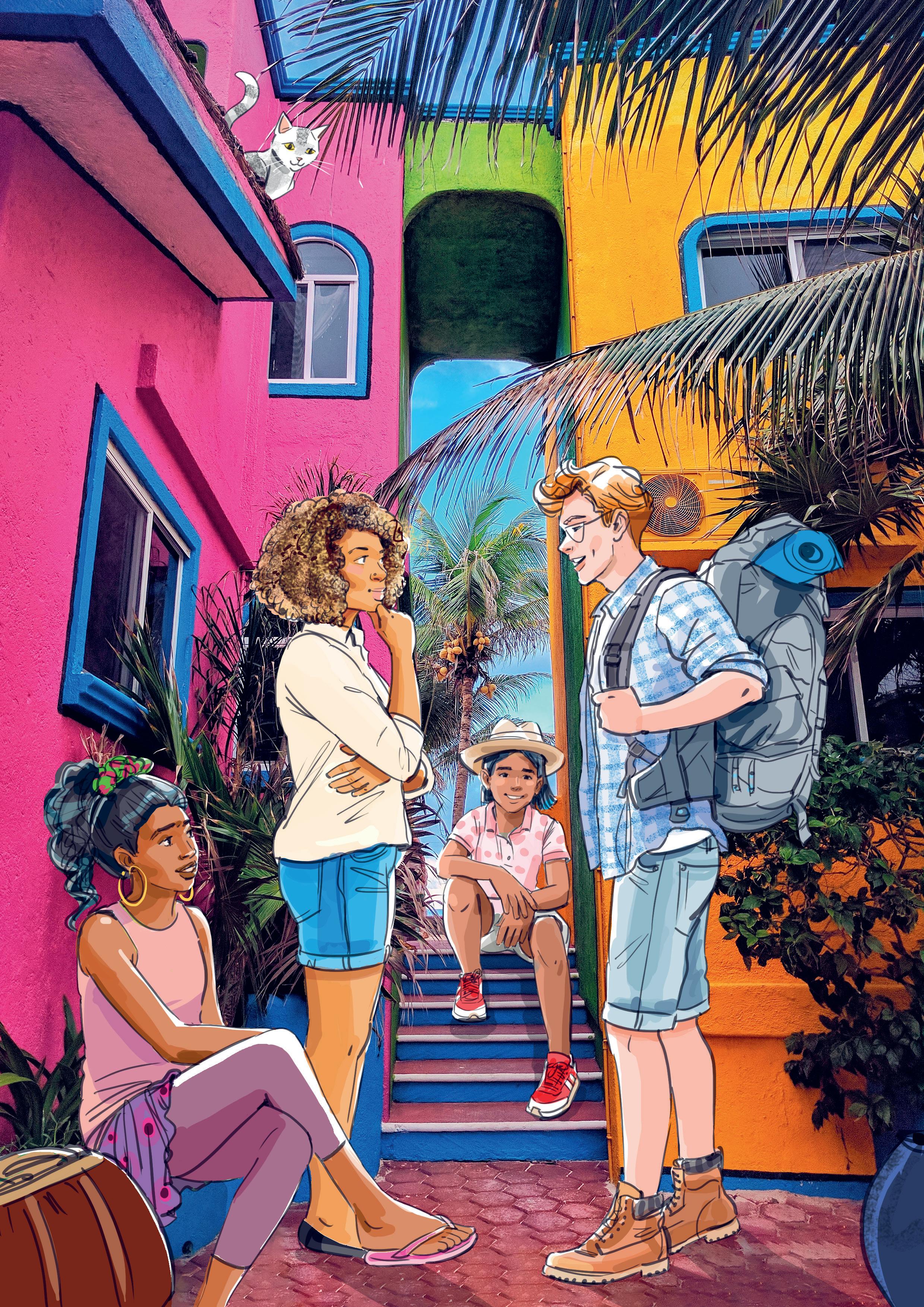
d) What does he find most challenging when travelling?
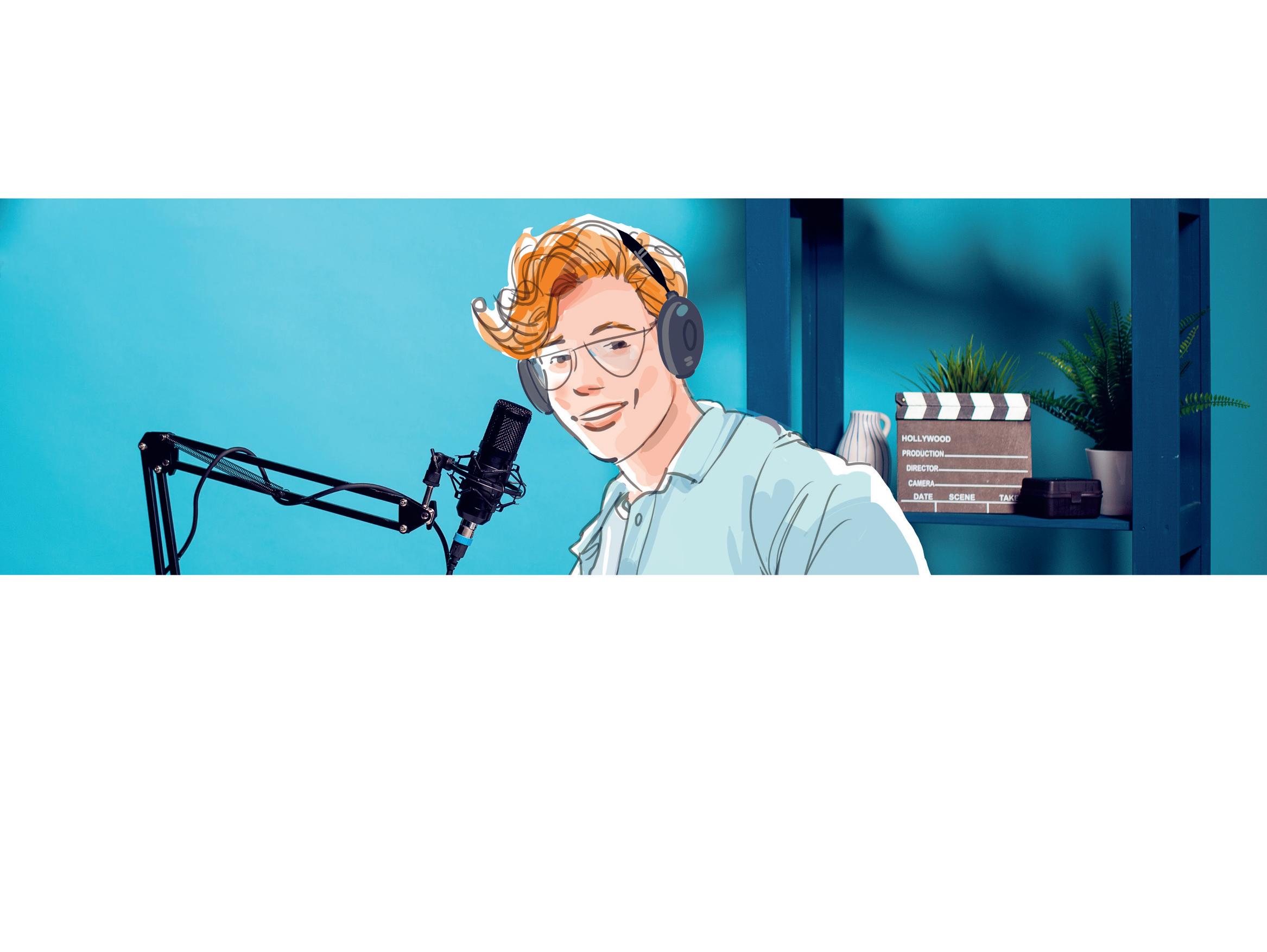
R mostly in English S he does not
O nothing P sleeping Q bad food R talking to strangers
e) What does he do if people he meets do not speak English?
A he uses body language B he is quiet C he starts to cry D it has never happened
f) Does he have any advice for other travellers?
A stay inside after dark B shower in the evenings C wear sunglasses D speak to people!
Which word did you get? ____________________________________________
Listen to Sean again. This time, write down what he says as keywords. Use these keywords to retell his story to your learning partner.

See Textbook pages 146–147.
1 Which city is the first city the blogger visited in this text?
M: Kiel N: Flensburg O: Hamburg
2 How did he get to that city?
H: by plane I: by train J: by car
3 “It was _____, so I took a taxi to the hostel.”
C: raining heavily D: snowing E: bucketing down
4 Which language did most people speak there?
A: German B: Swedish C: French
5 Which city is he going to next?
X: Flensburg Y: Kiel Z: Copenhagen
6 Which city is the third city the blogger visits in this text?
D: Flensburg E: Odense F: Dublin
7 The blogger met someone on his way to the third city. Who?
N: St Patrick O: An Irish couple P: A Danish couple
8 “We started talking about travelling and how we meet people from different _____ and cultures.” M: countries N: cities O: states
9 Which city is the blogger from?
E: Odense F: Hamburg G: Dublin
10 The blogger invited the couple to come and stay with him for a certain holiday. Which holiday was that?
M: Christmas N: St Patrick’s Day O: Chanukkah
11 Which is the fourth city the blogger visits in this text?
E: Oslo F: Odense G: Copenhagen
12 “If you believe travelling and speaking to strangers can help make new acquaintances, you’re _____!” R: correct S: wrong T: bang on
13 “I could tell they were a bit _____ in the beginning.”
R: nervous S: afraid T: anxious
14 Where is the blogger going next?
K: Next stop is Oslo, then Copenhagen.
L: Next stop is Copenhagen, then Oslo.
M: Next stop is London, then Dublin.
15 How does the blogger plan to get from Copenhagen to Oslo?
S: by ferry T: by bus U: by bike
16 “So, I must _____, lots to do before my train leaves!”
G: hurry up H: crack on I: be snappy
17 How many times do you find the word “people” in the text?
A: four times B: two times C: three times
How many gold coins can a leprechaun throw in an empty pot?
Where can you always find “gold”, but there’s no gold at all?
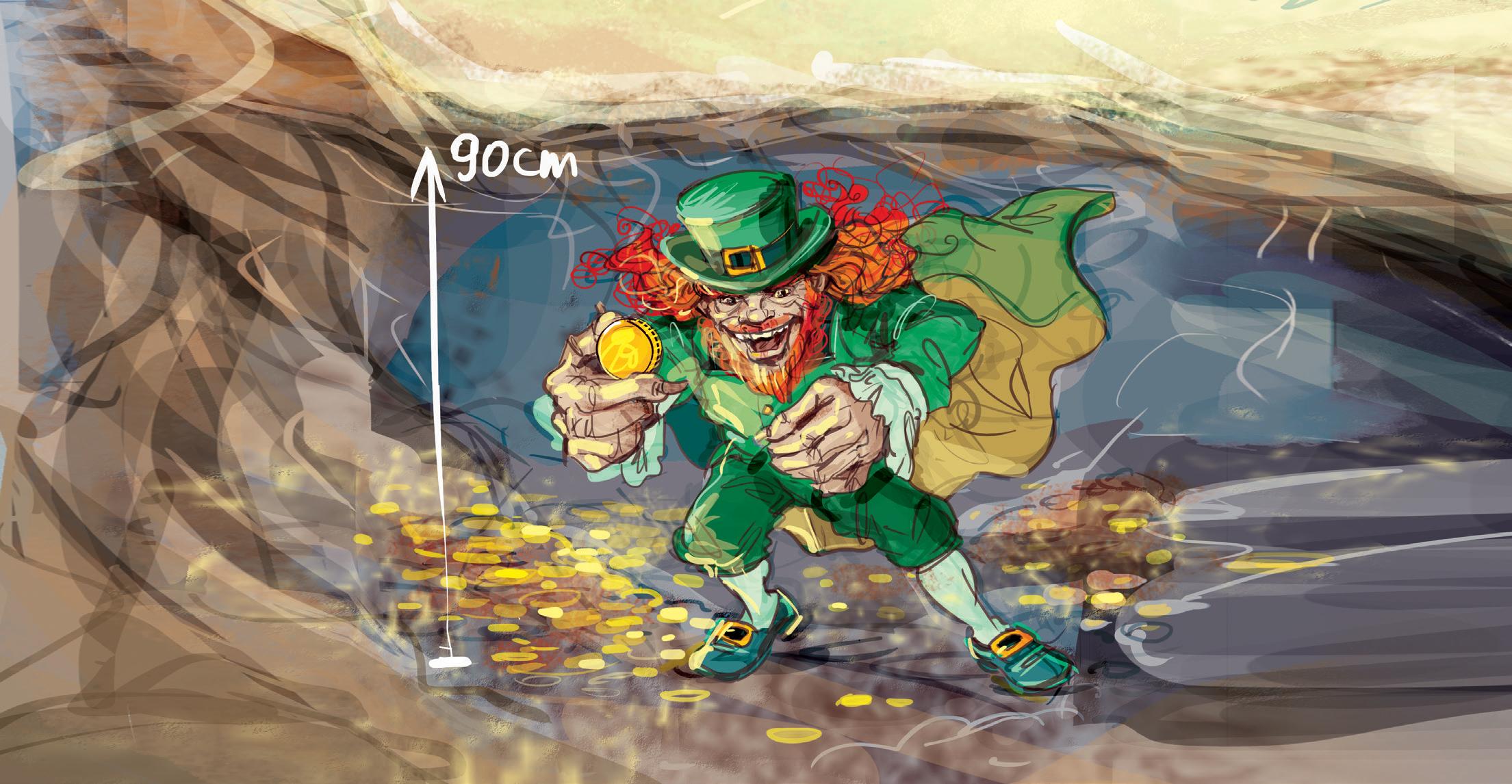
a) Which word class do the words belong to? See Textbook pages 190–193 for some tips. _____________________________________________________________________________
b) Find and circle the words above in this text:
I arrived in Hamburg last night by train. It was bucketing down, so I took a taxi to the hostel. The taxi driver didn’t understand what I said at first, but when I spoke slowly and used some gestures, we were fine!
On my way to Flensburg, I met a Danish couple. We started talking about travelling and how we meet people from different countries and cultures. They had never been to my hometown, Dublin, so I invited them to come over for St Patrick’s Day. In exchange, they invited me to their home in Odense for a couple of nights. So now, my plans have changed, and I’m going to Odense with my new friends.
I spent some amazing days in Odense with my new friends. I am so thankful they started speaking to me on the train. I could tell they were a bit nervous in the beginning, as English is not their native language, but we’ve had some amazing conversations the past couple of days.
c) Look at the words you have circled. Which verb form are they in? _____________________________________________________________________________
d) Can you find and circle more verbs in the text? Which forms are they in? _____________________________________________________________________________
e) Find and circle the nouns and adjectives. Use different colours.
f) See Textbook pages 190–193. Are there other word classes you can find in this text?
I can use my language knowledge and skills to compare different languages. Look at The Day Saida Arrived on pages 130–135 in Textbook. Which transparent words do you find? Compare the English words with Norwegian and/or any another language you know.
English Norwegian
I can use different resources to learn about words and phrases. Which of these resources do you often use to learn words and phrases?
a dictionary conversation with a learning partner read an explanation hear an explanation
an app: _____________________________________________________________________ other: ______________________________________________________________________
I can use resources to write and edit my text. Which of these resources do you often use to write and edit a text?
a dictionary
a writing program feedback from a learning partner/teacher
an app: _____________________________________________________________________
I can talk about the value/advantage of knowing other languages. Talk to your learning partner. Which languages do you speak or understand? Which languages do you hear spoken in your community? Do you ever wish you spoke more languages? Why, or why not? Which languages do you think are good to know, and why?
Talk to your learning partner. Do you ever use English words when you speak? Do you know of any words in the English language that came from a different language?
first second third next after finally then meanwhile
Imagine you meet a person that does not know anything about tug of war, potato races, throwing at cans, ring toss, or sack races. How would you explain these to them? Write down an explanation. Look at this example:

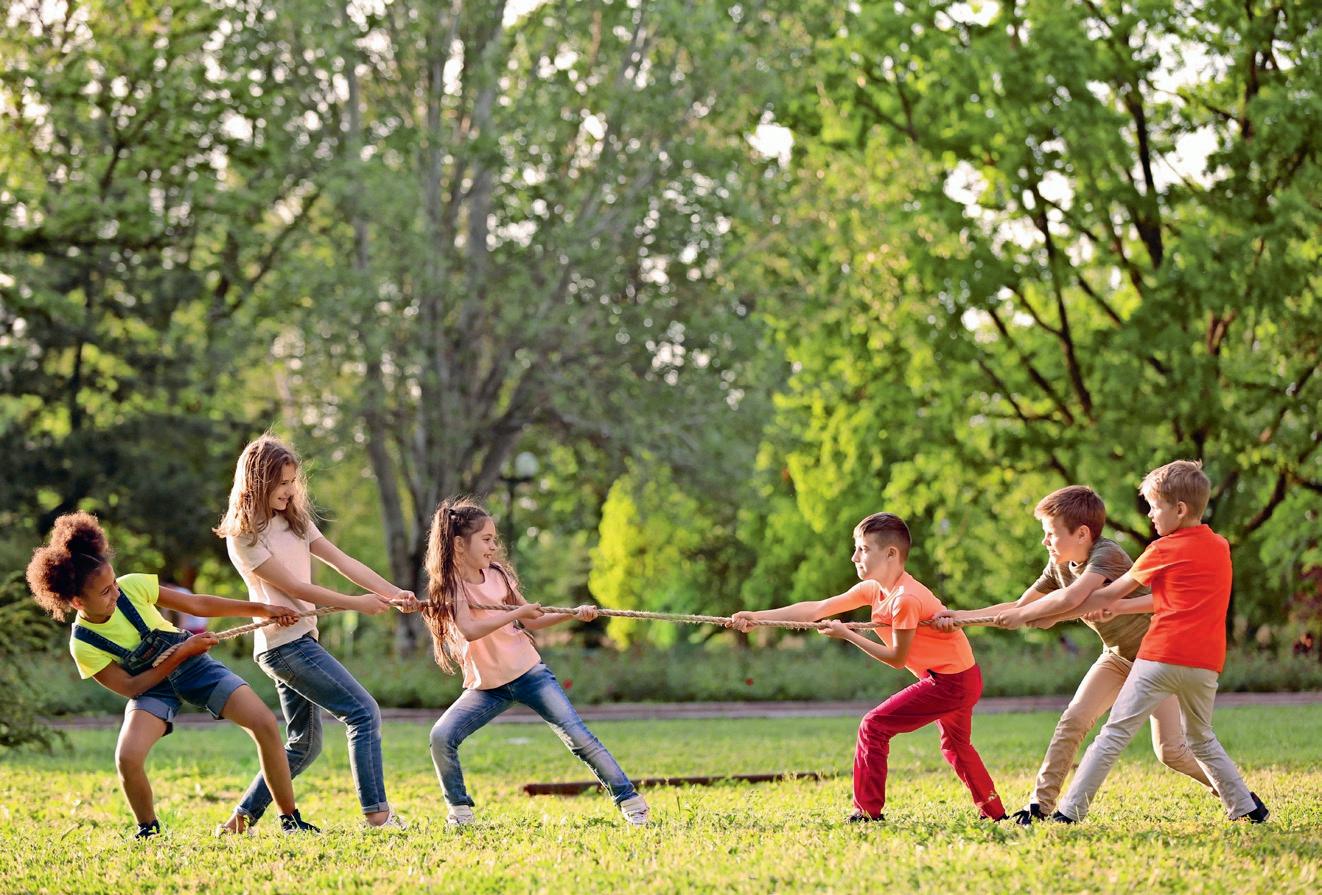
An equal number of players pick up each end of a rope. The players begin tugging the rope when the referee gives the signal. Each player pulls backwards as hard as they can. The teams continue pulling until the centre of the rope (tape mark) crosses where the referee is standing. The game ends when the referee declares one team has successfully pulled past the centre.
a) How to have a potato race ________________________________________________________________________________ ________________________________________________________________________________ ________________________________________________________________________________ ________________________________________________________________________________
b) How to play throwing at cans ________________________________________________________________________________ ________________________________________________________________________________ ________________________________________________________________________________ ________________________________________________________________________________
c) How to play ring toss ________________________________________________________________________________ ________________________________________________________________________________ ________________________________________________________________________________ ________________________________________________________________________________
d) How to have a sack race ________________________________________________________________________________ ________________________________________________________________________________ ________________________________________________________________________________ ________________________________________________________________________________
e) How to play ______________________________________ ________________________________________________________________________________ ________________________________________________________________________________ ________________________________________________________________________________ ________________________________________________________________________________
When you write instructions you often use verbs in the imperative form, which is a commanding form. Find the 20 verbs in the imperative form in this word search.
throw run walk go jump
pull stop hold grab listen
turn give look push take
put place mix open close
Use the words in the imperative form and give each other commands. “Jump five times.” “Look at the door handle.”
7.3 Make a vocabulary list. Find out what the different days mean:
Celebration days Explanation
national day
flag day
republic day
victory day
liberation day
constitution day
independence day
7.4 Factual and multimodal texts
Why and how are these days celebrated? Search the Internet and find out. Remember to list your sources. You can use a Venn diagram to compare the different days that are celebrated. What is similar? What is different?
Make a multimodal text and have a mini presentation, alone or with your learning partner.
Oral criteria:
– Speak loud and clear
– Adjust your tempo
– Make sure to make contact with your audience
Read the scenarios and decide if they are fair or unfair. Discuss with your learning partner.
Only children with black shoes are allowed to play football at school.
Your friend lets you cut in line in front of them at the drinking fountain. The line is quite long.
Your three-year-older sibling gets to stay up later than you.
The teacher had some leftover cake which he brought to his class. Two of the pupils were allergic, so they could not eat any of the cake.
Your friend brings her ball to school but won’t let you play with it.
You save a seat for someone in the cafeteria.
Your grandmother gives you 500 kroner for your birthday and your two-year-younger sibling 300 kroner for their birthday.
Tim is 5 years old, and Thomas is 15 years old. Thomas is going to the cinema with friends, so his parents give him 300 kroner. Tim gets 300 kroner too, so he can buy a toy he wants.
The city’s mayor has decided that his eldest son will be the next mayor and that there will no longer be elections each year.
The head of the police department decides he wants to be the mayor, so he puts the current mayor in jail.
A 3-year-old and a 10-year-old are served the same amount of food for dinner.
The 12-year-olds and the 6-year-olds are assigned the same amount of homework.
During school assemblies, the younger kids get to sit near the stage and the older kids are in the back of the room.
I help out in the house by feeding and walking our dog. My older brother helps out by washing the bathroom.
At the school library, each student can borrow up to 3 books.
Your teacher partnered up the class for an activity and you did not get to choose who to work with.
being equal being fair
________________________________________________________________________________ ________________________________________________________________________________ ________________________________________________________________________________ ________________________________________________________________________________ ________________________________________________________________________________ ________________________________________________________________________________ ________________________________________________________________________________
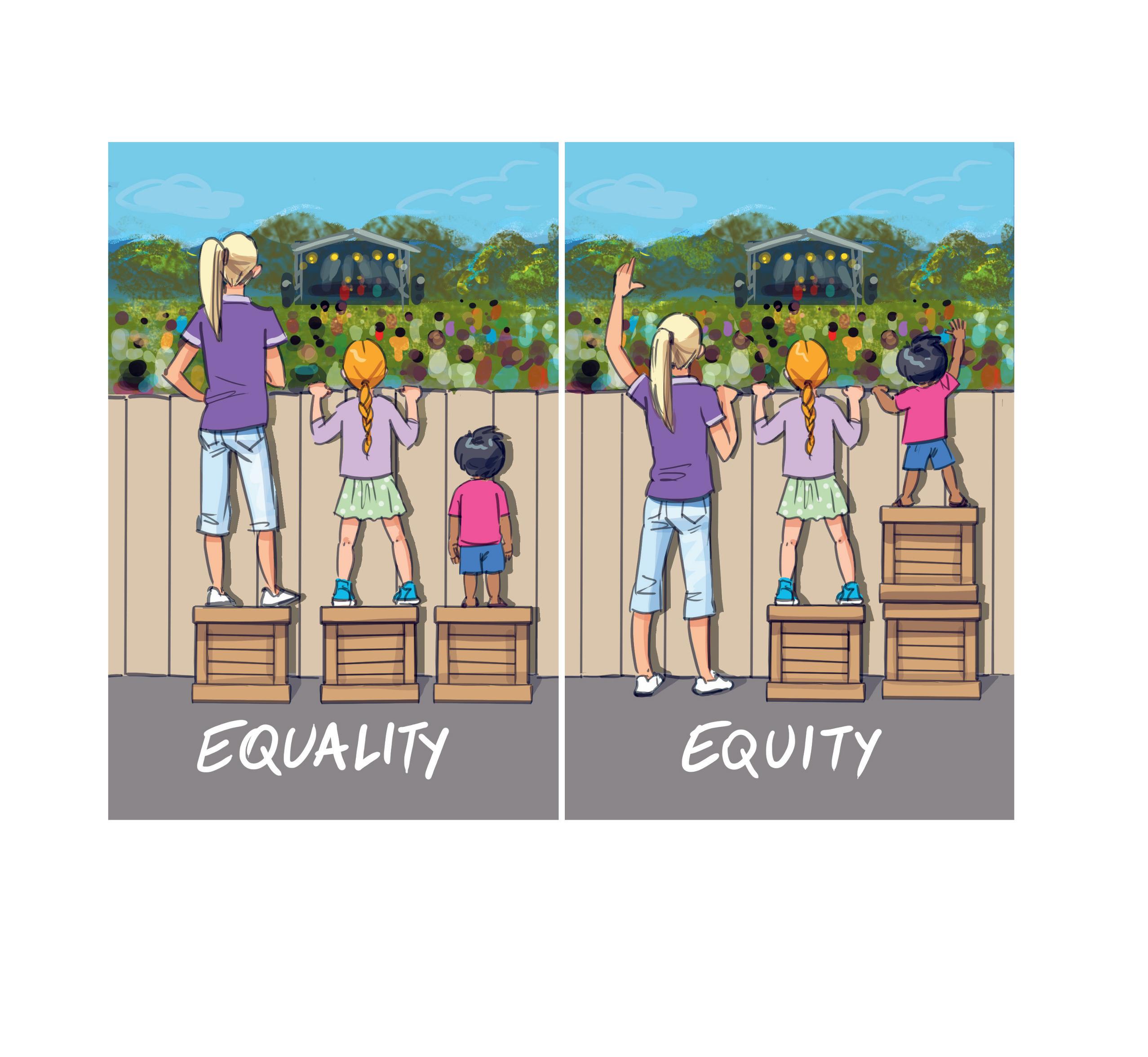
Listen to the interview. For each of the interview questions, write keywords based on the interviewee’s answers.
a) Do you have a national day of celebration where you live? ________________________________________________________________________________ ________________________________________________________________________________

b) Do you have other days of importance that are celebrated where you live? ________________________________________________________________________________ ________________________________________________________________________________
c) What do you do on those days? ________________________________________________________________________________ ________________________________________________________________________________
d) What does independence mean to you? ________________________________________________________________________________ ________________________________________________________________________________
e) What does democracy mean to you? ________________________________________________________________________________ ________________________________________________________________________________
Read the text and mark all the some and any you can find. Mark the compound words with some and any too, e.g., anybody, someone…
Jonathan: Wow. How is that possible? It would be like I could vote in elections, but not Mercy. That’s not fair.
Timo: I know. Luckily, it’s not like that in South Africa anymore.
Mercy: Really, I would love to go to Robben Island.
Jonathan: Me too! Maybe we could go together sometime?
Timo: Count me in! I’ll be the guide.
Thea: Have you been in India on Independence Day before, Aryan?
Aryan: Yes, I’ve been there two or maybe three times.
Amahle: Oh, I wish I could go to India on Independence Day someday.
Timo: Nice. But we don’t know what to bring to a 17th of May breakfast. Do you have any suggestions?
Mercy: I’m bringing some cheese and crackers. Maybe you could bring a fruit salad, Amahle and Timo? Or some sausages?
Timo: Good idea! I can make a fruit salad, if that’s okay with you, Amahle.
Amahle: Of course. I can bring some sausages. What kind of sausages do you want?
Jonathan: Surprise us. We’re not picky.
Amahle: But I don’t know anything about Norwegian sausages…
Can you spot a pattern? When is some or words with some used, and when is any or words with any used?
Find 14 words with some and any, including some and any. Write them down on the lines.

Any is used in questions and negative sentences: We don’t have any milk left. Do we need any eggs? No, we don’t need any eggs.
Some is used in positive sentences:
We have some eggs in the fridge. I would like some chocolate.
Some may also be used for questions, typically offers and requests, if we think the answer will be positive:
May I have some more chocolate? Would you like some juice?
7.9 Write some, any or anything in the sentences.
a) I want to make ____________ cupcakes.

b) Do we have ____________ flour?
c) No, we don’t have ____________ flour.
d) What about milk? Do we have ____________ milk?
e) Yes, there is ____________ in the fridge. I can see ____________ eggs too.
f) Okay, I’ll go to the grocery store now. Do you need __________________ ?
g) Yes, I would like ____________ bread and ____________ cheese, please.
h) Great. I’ll buy ____________ bread and cheese for you. And I’ll buy ____________ flour for the cupcakes. Oops, do we have ____________ sugar left?
i) Yes, there is ____________ sugar in the cupboard.
j) Okay, see you in fifteen minutes. Are you sure there isn’t __________________ else we need?
k) We don’t need _________________ else, but I think I would like ____________ grapes too.
Fifteen minutes later.
l) I’m back! Look, I bought ____________ honey too. Would you like ____________ honey in your tea?
m) Yes, please. I would really like ____________ honey in my tea.
Listen to the text and circle the correct answer.
a) The Sámi people are not indigenous in which country?
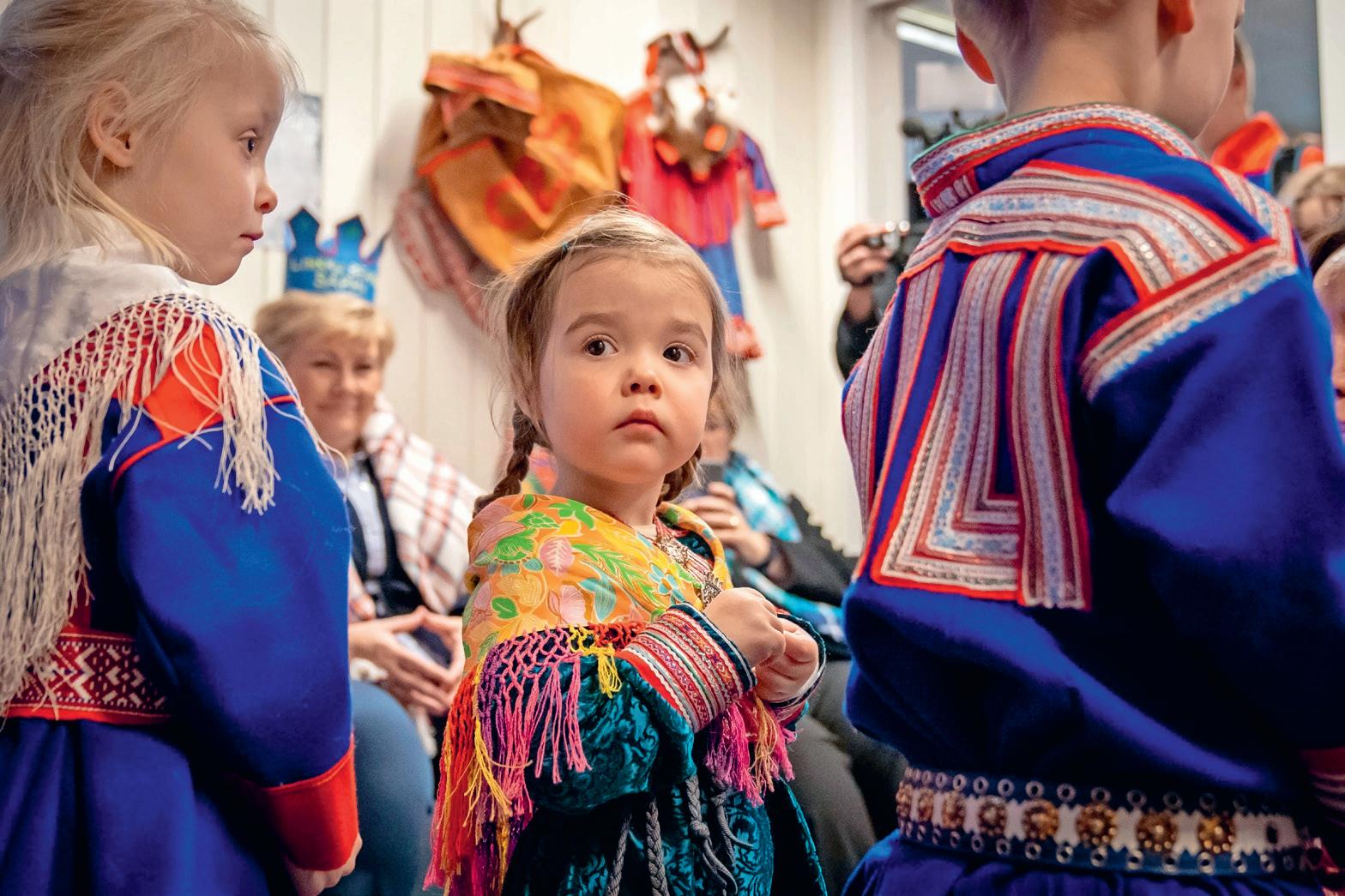
P Russia Q Sweden R Norway S Denmark
b) When is the Sámi national day?
A 6th of February B 6th of May C 16th of February D 24th of December
c) Which colours do you find in the Sámi flag?
P Red, green, yellow, and blue Q Blue and yellow R Red, white, and blue
S Red, yellow, and blue
d) Who designed the Sámi flag?
L Mikkel Gaup M Astrid Båhl N Astrid Mikkelsen O Aune Sand
e) When did the Sámi national day become an official flag day in Norway?
G 1814 H 1905 I 2003 J 2020
Which word did you get? What does this word mean? Use the Internet to find out.
Listen to the text again. This time, write down what you hear as keywords. Use these keywords to retell this story to your learning partner.
I can prepare to talk about something I have read. Choose a text you have read in this chapter. Prepare to talk about this text. For example: What is the text about? Did you like the text? Why / Why not? What did you learn? Write down some keywords and talk to your learning partner.
I can read and interpret content from different text types. Choose two texts you have read in this chapter or earlier in this book.
a) Name of the texts____________________________ ____________________________
b) Types of texts ____________________________ ____________________________
children’s book
song text
diary table
audio text graphic text
c) Talk to your learning partner about the main ideas in the text.
dialogue essay
d) How can you link these texts to the title of the chapter "Celebrations of nations"?
I can create written and oral digital texts and share with someone. Choose a text you have created in this chapter or earlier this year.
Title of the text: __________________________________________________________________
Type of text (written/oral digital text): _______________________________________________
How did you share the text? _______________________________________________________
With whom did you share the text? _________________________________________________
I can make comparisons between traditions in English-speaking societies and Norway. Think about a national day you celebrate or know about. Think about why it is celebrated, food, people, clothes, decorations, activities, and more. Share with your learning partner. Do you have different traditions? Can you think of other national days and traditions?
Capture using a camera frame it edit it flip it
Have fun experiment mess around enjoy yourself get results without the pressure
Brainstorming draw a draft type ideas combine colours scribble and erase add shapes
Speak your mind and record it reminders for yourself explanations for others inspiring thoughts

8.1 Circle the types of visualisation tools that might be useful for you. Tell your learning partner why they might be useful. Listen to their answers as well.
For me it would be useful to… because… I like this way… because… I also prefer... Why do you prefer...? Why do you think that is most useful to you?
I can retell an English children’s book.
When we retell a book or story, it can be useful to make a summary of the parts, or pick keywords that will help you retell it.
Read the text on pages 176–182.
8.2 Retell the story using keywords.
a) Search in the text for words you think are keywords.
Māori English
b) Retell the story to a partner using your keywords.
A summary is a short description of the text, usually only a few sentences. It should tell the reader about the different parts of the text: beginning, middle, and end. It should also mention the main characters and any main ideas. Remember: if you use phrases or sentences from the book, use quotation marks and reference your source.
8.3 Write a summary of the text
Sources:
8.4 Challenge: See Kopioriginal 8:1 with wordlist for The Greatest Haka Festival on Earth. Look at the warning under the Flying Wheke. What do you notice about the warning text? Write your own warning text about something else people should be warned about.
8.5 Reflect on the text. Choose one of the following words: What does it mean? What does it represent? What does it express? See Kopioriginal 8:1 with wordlist for The Greatest Haka Festival on Earth.
pūkana haka pōhiri waka ama
I can reflect on how I and others express ourselves through words, non-verbal signals, visuals, and performances.
8.6 Reflect on your community and your life.
Do you have events that allow you to express yourself, your identity, and your culture?
Where do people gather in your community? What do they do there?
Imagine you were moving to another place, and no one there knew about your traditions. What traditions would you want to keep alive? What would it mean to you to be together with others who held those same traditions?
Strategy: Choose a graphic organiser. Create and sort your ideas.
8.8 You can answer the questions alone, with your learning partner, or in a small group. You can answer the questions orally or in writing.
a) What is graffiti? ________________________________________________________________________________ ________________________________________________________________________________
b) What is a “tag”? ________________________________________________________________________________ ________________________________________________________________________________
c) What is street art? ________________________________________________________________________________ ________________________________________________________________________________ ________________________________________________________________________________
d) Is street art better than graffiti? Why / Why not? ________________________________________________________________________________ ________________________________________________________________________________ ________________________________________________________________________________
e) Would you like to be a graffiti artist? Why / Why not? ________________________________________________________________________________ ________________________________________________________________________________
f) Is there graffiti or street art in your town? If yes, what do you think of it? ________________________________________________________________________________ ________________________________________________________________________________
g) Are graffiti artists criminals? Why / Why not? ________________________________________________________________________________ ________________________________________________________________________________
h) Does anybody have the right to paint on somebody else’s property? Why / Why not? ________________________________________________________________________________ ________________________________________________________________________________ ________________________________________________________________________________
i) Have you ever been to a street art exhibition? If yes, what was it like? If not, would you like to go to one? What do you think it would be like?
j) Why do people feel the need to write their names on things, for example in a book, on a table at school, or on a wall in town? How is this connected with feelings of possession and belonging? ________________________________________________________________________________ ________________________________________________________________________________ ________________________________________________________________________________
k) Are you born with artistic talent, or can it be learned? ________________________________________________________________________________ ________________________________________________________________________________ ________________________________________________________________________________
l) What would the world be like without graffiti or street art? ________________________________________________________________________________ ________________________________________________________________________________
8.9 Code quiz – Have you ever been bored?
See Textbook pages 183–185.
1 What is bothering Mercy? R: She doesn’t feel well.
S: Nothing inspires her anymore. T: She has lost some of her friends.
2 What is Jonathan’s suggestion?
W: They can visit Jonathan’s cousin. X: Mercy could take art classes.
Y: Mercy could post her drawings on social media.
3 Who are Mercy’s followers on social media? G: People from all over the world. H: People from her school. I: Mostly her family and friends.
4 What is Jonathan’s cousin doing?
M: graffiti N: painting with oils on canvas O: working with clay
5 “What? _____? Is that even _____?”
N: Clay – inspiring O: Tagging – cool P: Graffiti – legal
6 Where is June doing graffiti?
A: on legal walls B: in her back yard C: at school
7 “I’m going to create a _____ here.” A: picture B: painting C: piece
8 “But there is already a street painting here. Are you going to _____ it?”
E: destroy F: paint over G: ruin
9 What happens if they do not follow the rules?
G: They must pay a fine. H: They won’t be allowed to paint there anymore.
I: All the paintings will be painted over with grey.
10 What is a positive side effect of taking your trash with you?
S: The stores will sell more paint. T: The paintings will get better.
U: Others won’t destroy what you’ve painted.
11 Why should you take a picture of the piece on the wall before you paint a new one? P: Because it is fun. Q: To keep it in your art album.
R: To do the former artist a favour.
12 Did Mercy like meeting June and learning about graffiti? R: No, she thought it was boring. S: She liked it somewhat. T: She thought it was very cool.
13 How many times do you find the word “legal” in the text?
M: three times N: four times O: five times
14 “But hey, better late than _____, right?” N: ever O: never P: always
What would you call a painting made by a cat?
Where do cows usually display their artwork? 3 13 4 14 14 14 14
What do artists draw before going to bed?

Digital storytelling (DST) is a method of telling a story using a digital tool. You record your voice as you tell the story, and you add pictures and/or music. By recording and editing, you can try many times and make adjustments before you show it to others.
– What story do you want to tell? (You can write your own or retell one you have heard before.)
– Which parts of the story do you want to highlight?
– Which pictures or illustrations can be suitable?
– What is the purpose of the presentation? (for example, to teach others something, to retell a story)
– Who is your audience?
– Write down keywords or the whole presentation.
Dos
– Make a storyboard for your story.
– Get to know the technology and the recorder.
– Prepare your script.
– Ask your learning partner or teacher for help.
– Be aware of your intonation.
– Share your digital story.
Don’ts
– Delete if you make a mistake. You might need that material later
– Underestimate the time needed.
– Panic if you make a mistake. Just try again!
8.10 In what ways can digital storytelling be an advantage when telling a story? ________________________________________________________________________________ ________________________________________________________________________________ ________________________________________________________________________________ ________________________________________________________________________________
When you are finished with your storyboard and your script, you are ready to record.
Finished recording your voice?
Tell or retell a story whilst you record your voice. Then…
Finished adding suitable pictures?
Find suitable pictures. Ask for help if needed. Then…
Finished adding suitable music or sound?
Find suitable music or sound. Ask for help if needed. Then…
Have you shown it to your learning partner?
Show your DST to your learning partner Then…
Publish!
How can this flowchart be useful?
A flowchart is a picture of the steps of a process in the correct order.
Collaborative writing is a method in which a pair, small group, or many students work to complete a writing project together. It is also known as interactive writing or shared writing.
Collaborative writing – how do we do that?
– Who will collaborate? (for example, learning partner)
– How will you collaborate? (for example, in a shared digital document)
– Why? (for example, to make a presentation, or to share or get ideas)
– When? (for example, in lessons or at home with a deadline)
Dos
– Make a plan.
– Keep your focus.
– Use one document/tab.
– Listen to each other.
Ask each other for help.
– Communicate to clarify any misunderstandings.
– Contribute and share good ideas.
Don’ts
– Avoid deleting parts of the shared text.
– Let people write their parts, without interfering.
– Do not stop others from modifying or correcting.
8.11
a) Choose 3 points you think are important and circle them.
b) Write your own “dos and don’ts” in a digital document, using your own words. Use the list above or add your own tips.
c) Why do you think is it important to have some ground rules when you use collaborative writing as a method? Talk with your learning partner.
d) How can collaborative writing help you in your own writing?
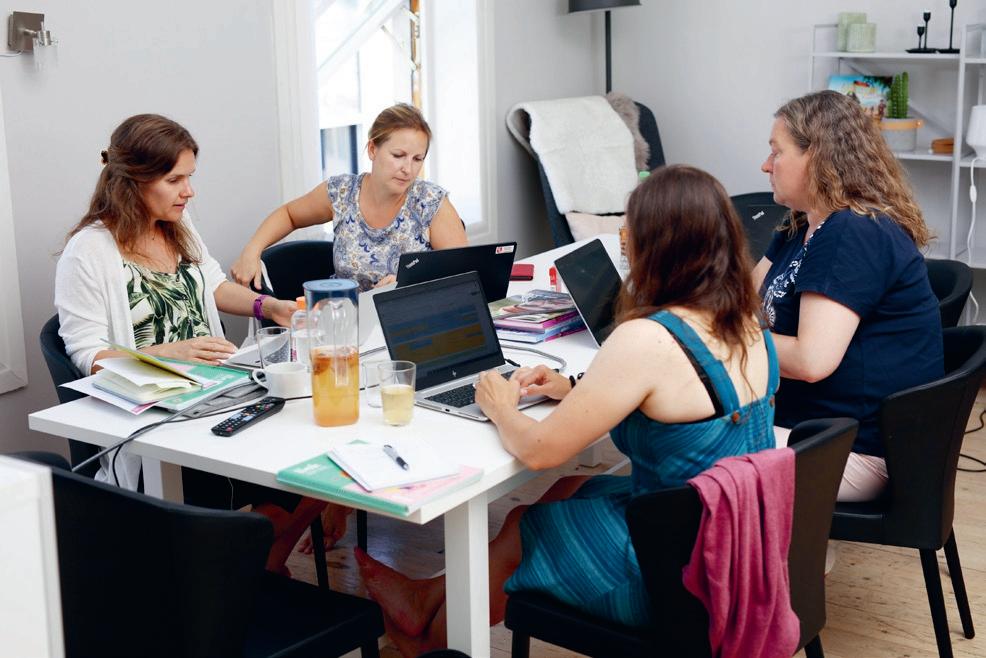
A coat of arms and crest is the graphic symbol of a family common in countries like England, Scotland, and Ireland. They can be made up of one symbol or design or a combination of symbols/designs. Examples include animals, flowers, and parts of flags. Where do you think these four coats of arms come from?
8.12
a) Pick 4 or more symbols to represent your family or yourself. Remember to think about what each symbol means to you and your family.
b) Draw your design below.
c) Share the meaning of your design with others by writing, speaking, or creating a multimodal text.
I can write a coherent text appropriate to the reader.
Art is considered to be an important part of society and a way to express oneself. Do you think it is important for young people to be taught art? Do you think young people should be encouraged to focus on art rather than other subjects? Why / Why not?
Prewriting activities:
a) Graphic organiser: Mind map or VENN-diagram
Art – important or not?
b) How will you write your text? Choose your own text type (See Textbook pages 210–213 for support). Make notes of text type features. ________________________________________________________________________________ ________________________________________________________________________________ ________________________________________________________________________________ ________________________________________________________________________________
c) Who is your target group? ________________________________________________________________________________ ________________________________________________________________________________ ________________________________________________________________________________ ________________________________________________________________________________
d) When you are done with your prewriting activities, write your text. Write your text on a digital device or by hand, or record it.
e) Peer assessment and edits. Switch your text with your learning partner’s text. Give each other feedback, for instance “two stars and a wish” (mention two things you liked and a wish for what could be better).
____________________________________________________________________________
____________________________________________________________________________
____________________________________________________________________________
f) Edit your text, make sure it is cohesive, and check for misspellings.
Make interesting, amazing, glorious, fantastic mistakes. Break rules. Leave the world more interesting for you being here. Make good art.
– Neil Gaiman, Art Matters8.13 Go back to the beginning of this book, to task 0.1. Look at the goals you decided on. Did you reach your goals?
a) Things I’m better at now: ________________________________________________________________________________ ________________________________________________________________________________ ________________________________________________________________________________ ________________________________________________________________________________ ________________________________________________________________________________
b) Things I can become better at: ________________________________________________________________________________ ________________________________________________________________________________ ________________________________________________________________________________ ________________________________________________________________________________ ________________________________________________________________________________
c) Two things I would like to become better at next year: ________________________________________________________________________________ ________________________________________________________________________________ ________________________________________________________________________________ ________________________________________________________________________________ ________________________________________________________________________________
I can express myself in ways appropriate to the context and to the listener. Talk to your learning partner about your favourite music. Follow these steps:
1 Pretend you are speaking to a grandparent or an elder person you know.
2 Pretend you are talking to a five-year-old.
3 Pretend you are talking to a friend.
Talk to your learning partner. Which of these “people” did you prefer to talk to? How did it feel to be spoken to in these different ways? Do you normally change the way you speak based on who the listener is? Why or why not? Remember to take turns and listen to each other.
I can read and retell a children’s book.
Retell the content of The Greatest Haka Festival on Earth on pages 176–182 in Textbook, or another children’s book, for your learning partner.
Did you like the text? Why or why not? Discuss with your learning partner.
I can use digital tools to share and work together with others. Which digital tools have you used in the chapter or earlier this year?
a presentation
a video
an audio recording
word processing documents, for example Power Point, Word, Google docs, Sway
an app _________________________________________
I can reflect on how I and others express ourselves through words, non-verbal signals, visuals, and performances.
Talk to your learning partner. What does art mean to you?
Talk to your learning partner. Do you ever express your thoughts or feelings through art? Do you express yourself through music, doodling or scribbling, dancing or singing? In what way? How do you use your hair, clothes, books, drawings, singing, or dancing to express yourself?
G1 Modifying nouns or verbs?
Look at the words in bold. Do they describe or modify nouns or verbs? Words that describe or modify nouns are adjectives. Words that describe or modify verbs are adverbs. Modifies...

What English word can be both a noun and verb at the same time?

5 12 9 18
I bumped into my old English teacher.
English is weird.
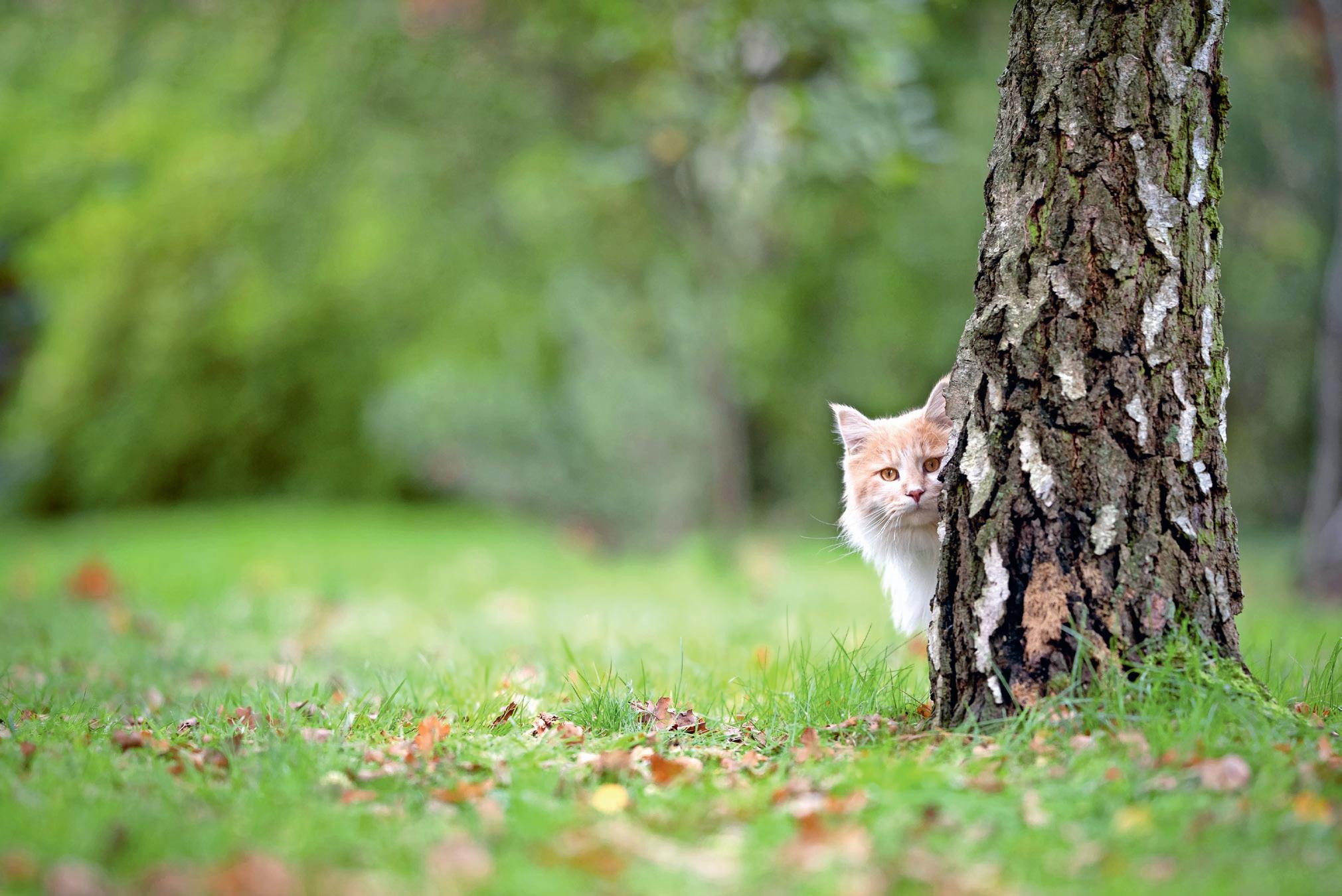


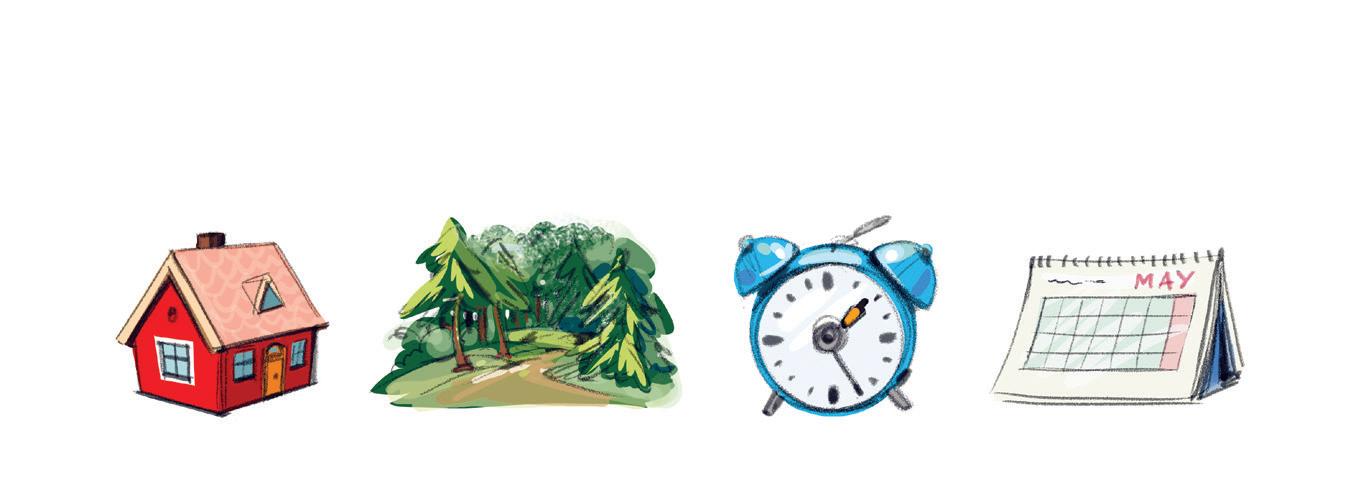

See Textbook page 194.
Look at the adverbs in the cloud. Can you use “where”, “when”, or “how” together with them? Examples:
The adverb “outside” describes where something is happening. “Outside” is an adverb of place.
The adverb “daily” describes when something is happening. “Daily” is an adverb of time.
The adverb “quickly” describes how something is happening. “Quickly” is an adverb of manner
outside daily quickly early often around below angrily gently next door
finally happily sadly lately never inside under behind just seldom
well nervously afterwards before wherever late slowly carefully elsewhere over
recently loudly towards seriously constantly along nearby perfectly quietly
a) Draw a line between the prefix and the word. Write the new word in the space to the right. im- appear pre- cycle dis- less un- view re- patient
b) Make the words using the following prefixes. pre- im- dis- un- re-
Noah felt like there were not enough hours in the day. There was an ______________________ in life. (balance)
I thought that they would ______________________ (approve) of the new book, but they actually liked it.
Matt and Marisa went to the library to do some ______________________ (search).
Sometimes when we meet new people we feel a ______________________ (judice). We should try to be aware of this.
He was ______________________(aware) of the dangers.
c) Find the suffix in the word. Write the suffix in the second column. Find a new word with the same suffix.
words with suffixes suffix another word painter er woollen beautiful quietly endless forgiveness backwards melted
d) Make the words using the following suffixes.
-ful -less -wards -ly -ness -er -ed -en
The children ______________________ (plant) the trees.
You ______________________(bright) my day.
There were ten ______________________ (play) on the field.
The feeling of ______________________(restless) was too much for her.
______________________ (lucky) they had another opportunity.
______________________ (after) they went to the movie.
The information was ______________________ (use). It was all out of date.
The children were very ______________________ (resource). They found plenty of paint for the project.
G4 Simple present or present continuous?
Sentence
1 I play chess every Thursday.
2 I am playing football right now.
3 Ellinor lives in Oslo.
4 She visits her grandmother every week.
5 Abdirahim is playing basketball with Eilif.
6 Zuzu goes to Poland every summer.
7 Iben is feeding her cat.
8 Her cat loves cat food.
9 Serhoz and Mohamed are writing a story.
10 They write at school on Mondays.
11 Rihanna and Malak love to draw.
12 Right now, they are drawing their teacher.
13 Arantza is living in Spain at the moment.
14 Caroline loves board games.
15 Sara is making a cake for her friends.
16 Tuva is making a pizza for her parents.
17 Aurora swims every Wednesday.
See Textbook pages 198–199.
What is the difference between a locomotive engineer and a teacher?
Why did the teacher write on the window?
G5 Write the correct form of the verb.
am sitting
I ____________________ on my chair at the moment. (sit(s) – am/is/are sitting)
I ____________________ to do this task correctly now. (try/tries – am/is/are trying)
Alcyone ____________________ up at seven o’clock every morning. (wake(s) – am/is/are waking)
Isabella ____________________ fruit for breakfast every morning. (eat(s) – am/is/are eating)
Samuel ____________________ cereal for breakfast at the moment. (eat(s) – am/is/are eating)
Emil and Fritjof ____________________ chess right now. (play(s) – am/is/are playing)
Mabel ____________________ dogs. (love(s) – am/is/are loving)
Natalia and Agnes ____________________ to dance. (love(s) – am/is/are loving)
Mateo ____________________ many books every week. (read(s) – am/is/are reading)
Right now, he ____________________ a book about wizards. (read(s) – am/is/are reading)
Oliver and Eik ____________________ to school every day. (walk(s) – am/is/are walking)
Mohammed Ali ____________________ lasagne. (like(s) – am/is/are liking)
He ____________________ lasagne for his friends right now. (make(s) – am/is/are making)
Charlie and Olav ____________________ for the lasagne to be ready. (wait(s) – am/is/are waiting)
They ____________________ on the sofa. (sit/sits – am/is/are sitting)
Adriane ____________________ ice hockey every Tuesday. (play(s) – am/is/are playing)
G6 Exploring different forms of the verb
Fill in the empty cells with other regular and irregular verbs and count the different verb forms.
Infinitive Present participle 3rd person singular, simple present (he-she-it)
Simple past
Tip! See Textbook page 191 and pages 198–199.
Past participle Number of different forms
Regular verbs work working works worked worked 4
live living lives lived lived play playing plays played played
was were
been
Irregular verbs go going goes went gone put putting puts put put be being am is are
What is the biggest number you can find? ____________________
What is the smallest number you can find? ____________________
Can you spot any patterns? ������������������������������������������������������� ________________________________________________________________________________
Challenge: How many different patterns can you find in the verbs in Textbook pages 202–203?
Write them down and compare them with another group’s patterns.
G7 Use your findings from the previous page and Textbook pages 202–203 to answer the following questions.
1 Write at least 5 verbs (in infinitive) with 3 different forms:
2 Write at least 5 verbs (in infinitive) with 4 different forms:
3 Write 5 verbs (in infinitive) that you think you use very often:
4 Write 5 verbs (in infinitive) that you think you use seldomly:
5 Write 3 verbs that have 2 syllables in the infinitive form:
6 Write a verb that has 3 syllables in the infinitive form:
7 Write 5 more verbs that have the same form in the simple past and the past participle verb form. Do not write the same verbs as in number 1.
8 Write 4 more verbs that have one vowel and follow the same vowel pattern as “to drink” in the simple past and the past participle verb form.
to win won won
to meet met met
to take took taken
I think ______________________ is the odd one out because ____________________________ ____________________________
to fly flew flown
to find found found to grow grew grown
I think ______________________ is the odd one out because ____________________________ ____________________________
to think thought thought
to take took taken
to throw threw thrown
I think ______________________ is the odd one out because ____________________________ ____________________________
to be was/were been
to go went gone
to tell told told
I think ______________________ is the odd one out because ____________________________ ____________________________
to understand understood understood
to leave left left
to hold held held
I think ______________________ is the odd one out because ____________________________ ____________________________
to swim swam swum
to drive drove driven
to sit sat sat
I think ______________________ is the odd one out because ____________________________ ____________________________
Compare your answers with your learning partner’s. Did you choose the same verbs as the odd ones out?
Read the sentences and write the verbs in bold in the correct places in the table.
1 Jonathan is very happy today.
2 He and his father are going to the carnival.
3 My sister and I are not feeling well today.
4 A bird is sitting in the tree.
5 What are you doing today, Mercy and Thea?
6 I think you are a very good friend, Aryan!
7 Amahle is hungry.
8 I am reading a book about hobbits.
9 My family and I were in Denmark last summer.
10 I was very happy in Denmark.
11 James was five years old when he got Charlie.
12 My twin sisters were four years old when they got a cat.
13 James and Thea, you were my best friends in kindergarten.
14 Timo, you were so cool when you dressed up as Pippi Longstocking!
15 Mercy was 11 years old when she got Scout.
16 The snake was relaxing in the sun.
When does Friday come before Thursday?
You see me once in June, twice in November, and not at all in May. What am I?
G10 Change the sentences into the simple past verb form. Underline the verbs.
See Textbook pages 200–201
Signal words for the past: yesterday, in 2020, this morning, a week ago, a month ago, two days ago, last night / last week / last weekend / last month / last summer / last winter / last Christmas
I draw a dinosaur.
Yesterday I drew a dinosaur.
She eats pizza on Fridays.
He sleeps in a tent.
We always speak nicely to our teacher.
They read a book about wizards.
I always lose when we play Yatzy.
My grandmother makes brownies.
James writes emails to his dad.
I do my homework after school.
G11 Write sentences using past participle verbs together with has/have/had. Underline both.
to break:
keep:
steal:
fall:
to know:
to say:
to see:
to stand:
to forget:
I have broken my leg twice.
Important! Remember has/have/had when you use the past participle verb form!
See Textbook pages 202–203. Throw a dice and move your game piece. Make one sentence with the verb in the simple past verb form, and one sentence using has/have/had and the past participle verb form. Say them aloud to your learning partner. Or: Say
conjugation of the verb, for example:
G13
a) Write two sentences about scheduled plans for next week. Use the simple present. ________________________________________________________________________________ ________________________________________________________________________________
Next week...
...next week.
b) Change these sentences from an event that happened in the past to something that will happen in the future.
I played rugby last week. ________________________________________________________________________________
We went to the movies last week. ________________________________________________________________________________
Next weekend...
Last year my grandparents came for Christmas. ________________________________________________________________________________
This year...
c) You are making plans for your next school break. What will you do with your friends? ________________________________________________________________________________ ________________________________________________________________________________ ________________________________________________________________________________
d) You are running for class president. Write 4 sentences about what you will do. ________________________________________________________________________________ ________________________________________________________________________________ ________________________________________________________________________________ ________________________________________________________________________________
I will… I am going to… I might… I am + (progressive)…
G14 Choose the right form of the verb to be
a) My dad ___________ baking a cake.
b) The birds ___________ singing.
c) I ___________ taking the train.
d) My family ___________ so funny.
e) Who ___________ singing that song?
f) We ___________ playing football.
g) They ___________ painting the wall.
h) ___________ I doing this correctly?
i) Who ___________ the new teacher?
j) No, I ___________ not ready yet.
G15 Choose the right form of the verb to do or to have and answer the questions in full sentences.
Example: ______ you play football? ����������������������������
To be am are – aren’t is – isn’t
Do or have do – don’t does – doesn’t have – haven’t has – hasn’t Do No, I don’t play football.
a) ________ you speak English? ���������������������������������������������������
b) What ________ you done? �����������������������������������������������������
c) ________ you done your chores? ������������������������������������������������
d) She ________ lived in London for two years.
e) Please, ________ do that.
f) She ________ many activities after school.
g) No, he ________ like the film.
h) Why ________ you answered any of the questions? ���������������������������������
i) The teacher ________ finished talking yet.
j) ________ you like fixing cars? ���������������������������������������������������
G16 Circle the modal auxiliary verbs.
a) We shouldn’t throw away food.
b) You can’t park here.
c) Could I have a glass of water, please?
d) Can you sing me a song?
e) Would you like to go by train or bus?
f) I won’t go to the concert.
g) Can I go to the toilet, please?
h) You should drink more water.
G17 Fill in the correct modal auxiliary verb.
a) You ________ sleep at night.
b) I ________ put my bike here.
c) ________ it rain tomorrow?
d) ________ I have an ice cream, please?
e) ________ I play the guitar?
f) ________ you like to join me?
g) You ________ brush your teeth twice a day.
h) Alex ________ speak Italian.
i) ________ you help me with this, please?
j) You ________ touch anything in the museum.
The modal auxiliary verbs are: can could may might must
ought shall should will would
a c j b t d w r m s i a j c h o p
a r e c y z t l k h o u i z n s l
o u x h a d f s h o u l d z c h y
p c w e r e f y m u m m h u i a n
b x q s a i z w a l x p x d s l e
e i v q v s q o y d e m c o u l d
t c r m v t k g j m g y d y m b e
n e d i d h a v e i w o u l d e s
u a r f d p o c p g m u l w x b w
n f e d k h m d u h e x x l m v v
y h c k m j i u q t f f g h r a v
c j b f v p v k r j v z h a y a m
k m e h p b z d p s s h s s w f u
l n e y g w u o p b f c g p a x s
c u n x d o e s p j n h h v s r t
i w w i l l e a g j v u w e r a m
c a n t c t b e i n g t f r m j u
must can were would might will
was should may shall are did
been had am does being have
is do be has could
G19 Look at these words that end with s
How do the s or ’s give different meanings to the words?
Words that end with s Write or draw an explanation
Amy’s Mads’s family’s it’s that’s what’s eggs waffles
sausages
What is the difference between dogs and dog’s? Explain. ________________________________________________________________________________ ________________________________________________________________________________
What is the difference between dog’s and dogs’? Explain. ________________________________________________________________________________ ________________________________________________________________________________
Write sentences with the words in the textbox.
squirrels squirrel’s
children children’s
See Textbook pages 206–207
Amy’s cat is white.
Amy has a white cat. ������������������������������������������������������������
Rachel has a blue scarf. ___________________________________________________________
Sophia has a green dress.
The dog has a red collar.
Helga has a blue jacket.
Sarah has white shoes.
Mary has a brown purse.
Daniel has a red shirt.
Hanne-Mari has a white school bag.
Tormod has blue trousers.
Kjetil has a green jumper.
We have two dog
The toys all over our floor are our dog___
One of our dog
Our dog___ like to go for long walks.
When we meet other dog___ they like to play together.
What does it mean to live a dog___ life?
I think that our dog___ have a pretty good life.
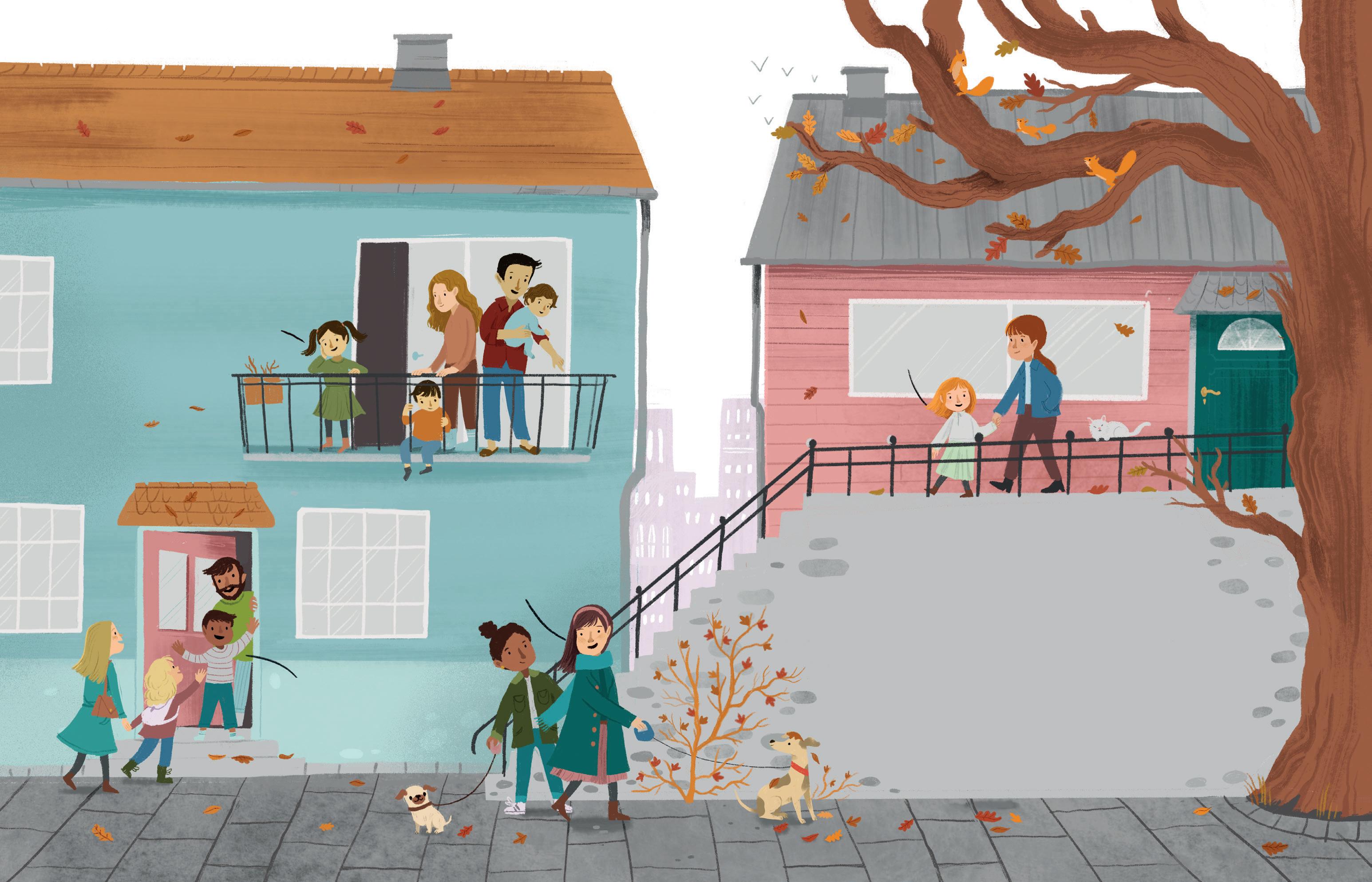
Write sentences with the words.
dogs – food:
brothers – clothes:
sisters – games:
my friends – house:
squirrels – nuts:
birds – nest:
children – toys:
women – dogs:
men – shoes:
Normally we do not use the s-genitive with objects (only with people or animals). With objects we most often use the of-genetive: The name of the street. (not “The street’s name”.)
Rewrite the phrases using the of-genitive.
The house’s roof:
The car’s wheels
The wall’s colour:
The game’s name:
The mountain’s top:
The table’s legs:
The forest’s lakes:
See Textbook pages 206–207.
What does “the name of the game” mean?
This is the dogs’ food.
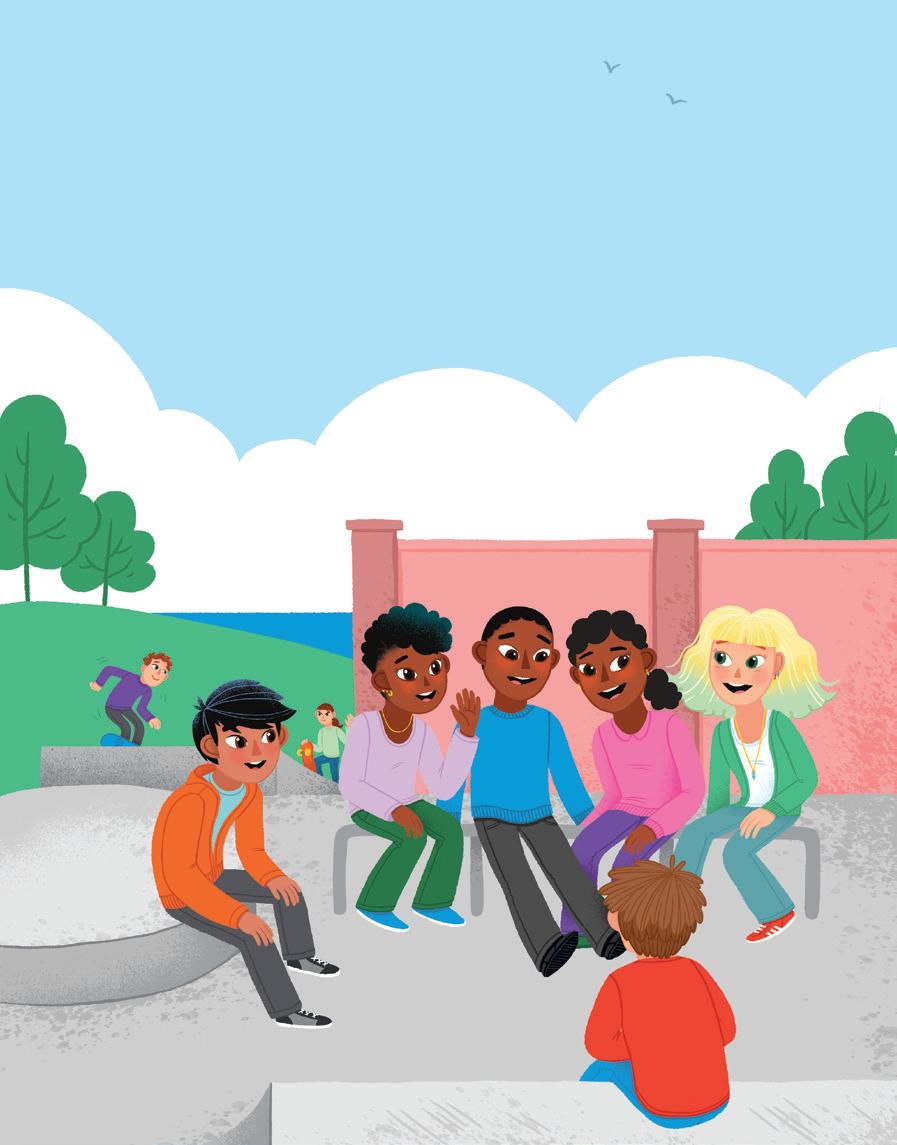
G24 Write the words in the correct boxes.
Timo’s cousin that’s
the election of 1994 the 27th of April
the 17th of May my mother’s house children’s parades
Timo’s friends what’s the 15th of August
Genitive-s (Thea’s jacket)
it’s let’s I’m I am
Of-genitive (the name of the street)
Contractions (she’s, etc.)
G25 Scan Textbook pages 154–157 and find the contractions. Write them down and split them into two words.
G26 Find synonyms.
We can use synonyms to vary our language. Find synonyms for the words in the table. You can find them in your head, ask your learning partner, or look them up in a thesaurus on the Internet.
Word Synonym Another synonym Yet another synonym angry irritated annoyed cross
G27 Replace the underlined words with synonyms. Use a thesaurus to help you find different alternatives. Which one do you think fits best? Why?
Mercy is very kind ��������������������������������������������������������������
Jonathan is tired today. ����������������������������������������������������������
Inger is watching an exciting movie. ������������������������������������������������
James wants a huge ice cream. ����������������������������������������������������
Matthew likes spicy food. ���������������������������������������������������������
Timo is intelligent ��������������������������������������������������������������
Amahle is thrilled about meeting Timo’s friends.
Thea loves horses.
Synonyms are words that mean almost the same. Antonyms are words that mean the opposite. Find out whether the words are synonyms or antonyms and solve the code.
1 happy – sad
2 talk – speak
3 run – sprint
5 big – small
I’m tall when I’m young, and I’m short when I’m old. What am I? 17 16 17 15 14 13 12
What goes up but never comes down? 11
The more of this there is, the less you see. What is it?
14 17 7 5 15 12 3 3
Forward I am heavy, but backward I am not. What am I?
G29 Complete the statements with the correct linking words from the word bank.
a) My sister is very shy, ____________ I am an extrovert.
b) ____________ of going to the cinema, they decided to stay at home and watch a DVD.
c) ____________ you leave now, you will miss your train.
d) ____________ you read many books, you will learn more words.
e) We can’t forget the umbrella ____________ they have forecasted rain.
f) I went to bed too late last night, ____________ I was so tired this morning.
g) I used to prefer fantasy. ____________, lately I have been reading more mysteries.
h) My neighbours had an accident ____________ they were going to work.
word bank whereas instead unless if because so however while
G30 Write instructions for someone to do something, using some of the following linking words for sequencing.
________________________________________________________________________________ ________________________________________________________________________________ ________________________________________________________________________________ ________________________________________________________________________________ ________________________________________________________________________________ ________________________________________________________________________________
word bank first second third next then finally
G31 Compare two things - for example Thai food and Mexican food. Use linking words for comparison. ________________________________________________________________________________ ________________________________________________________________________________ ________________________________________________________________________________ ________________________________________________________________________________ ________________________________________________________________________________ ________________________________________________________________________________
word bank
To contrast/show dissimilarity: in contrast, on the other hand, conversely, however, nevertheless, meanwhile, on the contrary, despite this, in comparison, whereas, while, although, even though, but
To equate/show similarity: in the same way, similarly, likewise
G32 Write sentences using linking words to show cause and effect. Try to use at least two different linking words. ________________________________________________________________________________ ________________________________________________________________________________ ________________________________________________________________________________ ________________________________________________________________________________ ________________________________________________________________________________ ________________________________________________________________________________
Example: I arrived late because the bus was stuck in the snow.
word bank
therefore, thus, hence, consequently, as a result, for this reason, accordingly, because, since, as, otherwise

a) Turn the following simple sentences into complex sentences. Use the words in the word bank for help.
The boy liked strawberries. They were sweet.
The pupils sit at their desks. School starts.
John and Jill were afraid. The movie was scary.
I want to go swimming. It is hot outside.
Marie was late for school. The bus came 10 minutes late.
word bank because since when
b) Add the correct linking word to the complex sentences below. Use the words in the word bank for help.
___________________ dinner was ready, they sat down at the table.
___________________ the weather is nice, we go for a walk.
___________________ they arrive, we will eat.
___________________ it rains, we need to remember our umbrella.
___________________ weather is nice this weekend, we will go camping. Toby can’t come out to play ___________________ he finishes his homework.
c) Write your own complex sentences.

Look at the words in the cloud. How similar are they to the word “talk”? Look at how the words are placed on the arrow. Do you agree with how the words are placed?
Now, look at the next word and the words in the cloud. Place the words on the arrow where you think they fit. Compare with your learning partner. Use a thesaurus. Look up the first word. Does the
give other alternatives?
large huge important great tall
small
heavy
glad thankful thrilled smiling ecstatic
enormous colossal mighty happy
jolly satisfied optimistic content over the moon hopeful sad
down heartbroken blue
see spy observe follow witness
look check out view
study stare inspect
depressed disappointed miserable watch
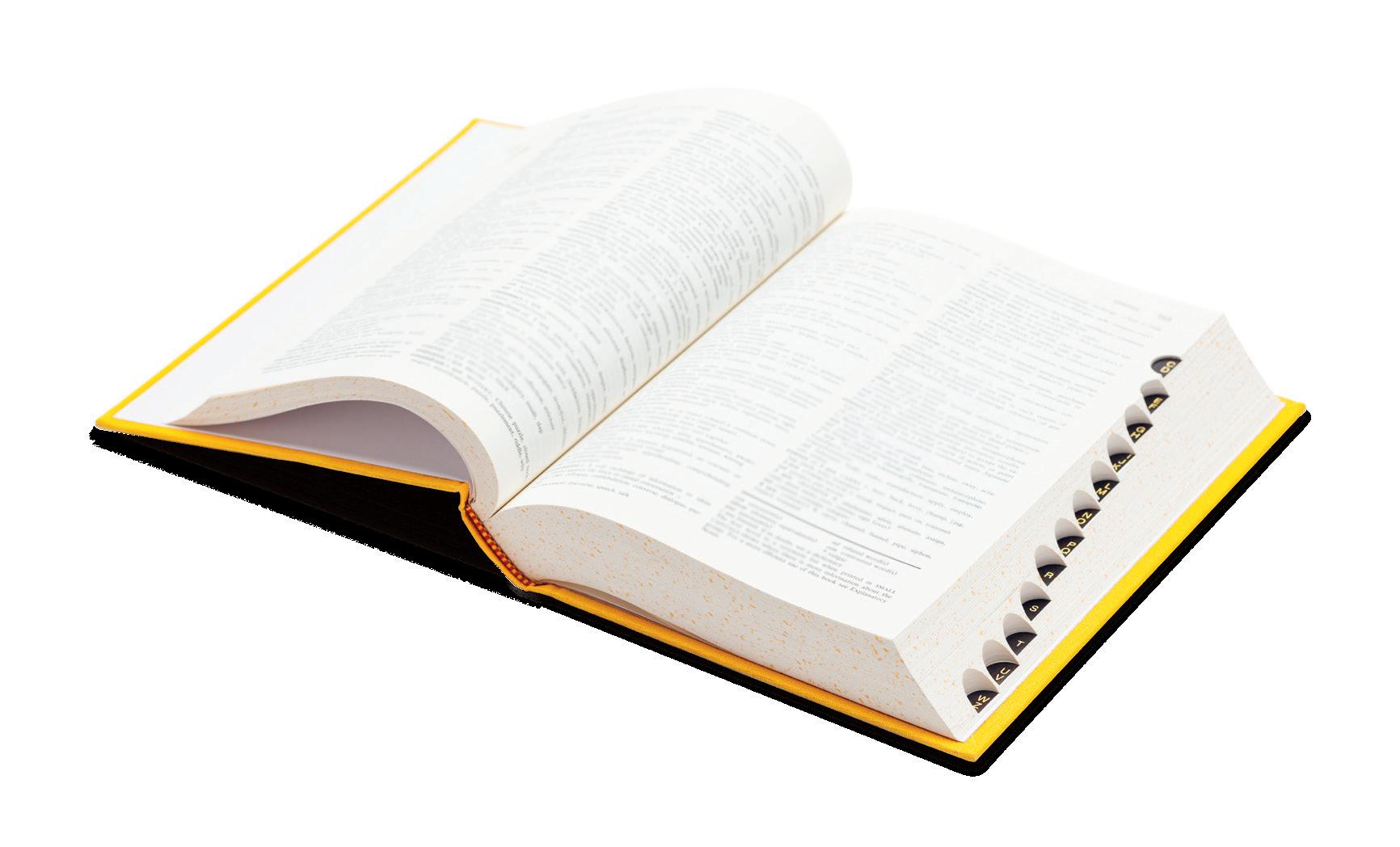
G35
We can find lots of information about a word in the dictionary.
match
n. a slender piece of wood, cardboard, or other flammable material tipped with a chemical substance that produces fire when rubbed on a rough or chemically prepared surface.
n. Sports: a game or contest in which two or more contestants or teams oppose each other: a soccer match
v. (used with object) to equal; be equal to: My talent does not match his.
A Entry word: A word that is the subject for an entry in the dictionary.
B Pronunciation: The way in which to speak the word.
C Part of speech/word class: A category to which a word is assigned. These include: n. (noun) v. (verb) adj. (adjective) adv. (adverb) pron. (pronoun) conj. (conjunction) prep. (preposition) interj. (interjection)
D Definition: The meaning of the word.
E Alternative definition: Another definition; some words can have more than one meaning.
1 Write the definition that fits the meaning of the word “match” in the following sentence: “They won the match.”
tie /taɪ/
v. to bind, fasten, or attach with a cord, string, or the like, drawn together and knotted
v. to make or be the same score; be equal in a contest
n. a necktie
n. a bond or connection, as of affection, kinship, mutual interest, or between two or more people, groups, nations, or the like
a) What is the entry word? __________________________________
b) What part of speech is the entry word? __________________________________
c) How many syllables does the word have? __________________________________
d) Does it have more than one definition? _________ If yes, how many?_________
e) Write the definition that matches the meaning of the word “tie” in the following sentence: Their family had strong ties. _______________________________________________________________________________ _______________________________________________________________________________
3 Now it’s your turn! Use the following words to practise using the dictionary and thesaurus. Choose one and write your answers below. Challenge: Look up more!
migration · moving · identity · express · art
a) What is the entry word? __________________________________
b) What part of speech is the entry word? ___________________________________
c) How many syllables does the word have? __________________________________
d) Does it have more than one definition? __________ If yes, how many? __________
e) List at least one definition. ����������������������������������������������������� _______________________________________________________________________________
s. 7 © MZStock / Shutterstock, s. 12 © Zhukovskaya Olga / Shutterstock, s. 22 © Song about summer / Shutterstock, s. 23 © YanLev Alexey / Shutterstock, s. 24 © Golden Pixels LLC / Shutterstock, s. 31 (1) © Damir Khabirov / Shutterstock, s. 31 (2) © Rvector / Shutterstock, s. 34 © Granger REX / NTB, s. 38 © Ymgerman / Shutterstock, s. 39 © Yuriy Brykaylo / Shutterstock, s. 40 © Andrei Kuzmik / Shutterstock, s. 45 © Arand / Getty images, s. 50 (1) © ViDi Studio / Shutterstock, s. 50 (2) © AJP / Shutterstock, s. 50 (3) © UfaBizPhoto / Shutterstock, s. 50 (4) © Anfisa Che / Shutterstock, s. 54 © Anton Vierieten / Shutterstock, s. 56 © New Africa / Shutterstock, s. 60 © LightField Studios / Shutterstock, s. 70 © amphotora / Getty images, s. 72 (1) © Matthias Kulka / Getty images, s. 72 (2) © oatawa / Shutterstock, s. 80 © New Africa / Shutterstock, s. 86 © melitas / Shutterstock, s. 100 (1) © Ez-Stock Studio / Shutterstock, s. 100 (2) © New Africa / Shutterstock, s. 106 © Manaf Kamil / Shutterstock, s. 108 © GS23 / Shutterstock, s. 110 © Heiko Junge / NTB, s. 112 © ayunings / Shutterstock, s. 116–117 © Milano M / Shutterstock, s. 119 © Tala-Natali / Shutterstock, s. 123 © Abubakar Danish / Shutterstock, s. 123 © Ava Bitter / Shutterstock, s. 129 © Soloviova Liudmyla / Shutterstock, s. 130 (1) © Jacob_09 / Shutterstock, s. 130 (2) © Nils Jacobi / Shutterstock, s. 130 (3) © Pavel1964 / Shutterstock, s. 154–155© LeManna / Shutterstock
s. 8 Illustrations, by Gordon C. James, copyright © 2020 by Gordon C. James; and Entire Text from I AM EVERY GOOD THING by Derrick Barnes, text copyright © 2020 by Derrick Barnes. Used by permission of Nancy Paulsen Books, an imprint of Penguin Young Readers Group, a division of Penguin Random House LLC. All rights reserved.
s. 70-71 Words and Music by Joe South
Copyright © 1971 Bike Music c/o Concord Music Publishing
Copyright Renewed
All Rights Reserved Used by Permission
Reprinted by Permission of Hal Leonard Europe Ltd.
vektlegger felles, flerfaglige aktiviteter og dybdelæring.
I link har vi fokus på interkulturell kompetanse, og vi følger fem gjennomgangsfigurer, fra 1. til 7. klasse.
link bygger på oppdaterte læreplaner og tar elevene på alvor i en ny hverdag.
• Arbeid med interkulturell kompetanse setter engelskfaget i en global sammenheng.
• Engelskspråklige tekster gir bakteppe for nye perspektiver.
• Lese- og skrivestrategier lar elevene jobbe aktivt med innhold.
• Oppgaver med vekt på utforsking utvikler elevenes evne til refleksjon.
• Elevene jobber med kommunikasjon gjennom samhandling og fellesskap.
• Oversikt og dybdelæring gir sammenheng i lærestoffet.
• Systematisk språklæring gir et godt grunnlag for videre arbeid med faget.
Komponenter på 7. trinn
•
•
•
Digitale ressurser for elev og lærer. Alle bøker er tilgjengelige i digital utgave, som d-bok.
Les mer om verket på www.fagbokforlaget.no